Poznań

City Guide

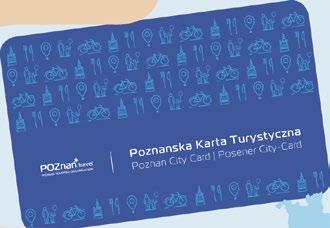








A city of half a million with a history dating back to the 8th century, Poznań is considered a likely site of the baptism of Polish ruler Mieszko I and thus the birthplace of the Polish state.

Today, this vibrant city is the capital of the Wielkopolska region and a popular business and tourism destination. Poznań’s historical eras - as the residence of early Polish kings, a medieval trade hub, the fortified Prussian city of ‘Posen,’ 2 decades in independent Poland, a stronghold of the Third Reich, and finally its return to Poland after WWII - have created a city with rich architecture and diverse cultural attractions. While part of Poz’s beauty lies in aimlessly roaming the streets and alleys, making chance findings from one turn to the next, there are a number of must-see sites whose discovery should not be left to chance - and this is where we come in.
While Poznań is not often the first city on travelling itineraries, it will prove a pleasant surprise to any who end up here. Laid with cobblestone, colourful burgher houses and a miriad of religious structures, Poznań’s Old Town (p.16) is a collage of architectural styles stuffed with soaring historical monuments, esoteric museums, art galleries and theatres, and more than its fair share of restaurants (including the recent addition of Michelin star’d and/or recommended culinary spots - p.60), bars and cafes. A major cultural and economic centre, Poznań has earned an international reputation as a city of trade fairs (p.36), its success stemming partly from its convenient location as a mid-way point on the road from Paris to the far east of Europe.
In Poznań, it’s not all about business, however. Over 100,000 people, some 20% of the population, purport to study here at some institute or another, lending a defiantly young and vibrant atmosphere to the streets. Whether you’re here for business or leisure, by exploring our paper guide you’ll find everything you need to enjoy this city, whether it be bars (p.68), clubs (p.70), restaurants (p.56), museums, (p.40) or even kayaking down the Warta River (p.8).
Poznań In Your Pocket is designed to provide you with all of the ideas, tools, and information you need to explore the city on your own, stay offline as much as possible, and really connect with the city you’re visiting.
Over here at IYP we still believe that the best way for visitors to discover any city is on foot, and we’ve designed our Poznań guide accordingly. Our Sightseeing chapter is organised into geographic areas of interest with detailed district maps to help you navigate them. District tours include descriptions of all the most important sites, plus local tips on where to eat and drink in each area. You might also find intriguing ‘Crossroads’ moments that allow you to be lured towards alternative adventures, either on foot or via public transport.
Throughout the guide, page references are liberally used to lead you to related info on a topic elsewhere in the guide, while QR codes will take you to our website when we feel there’s more to know than can be expressed in print. Each venue listing includes a map coordinate that correlates to the city map on p.4. If there’s a specific venue you’re searching for, use the Index in the back of the guide (p.74) to quickly find it, or simply follow our informed suggestions.
Statue depicting Poznań’s legendary mascots - a pair of goats butting heads. This sculpture, made by Robert Sobociński, was unveiled in 2002 in Plac Kolegiacki (p.17). Due to city works, it has been temporarily moved to Chopin Park (I-8).

Photo by Darek Bednarek.
Of course, space in our print guide is a finite resource, but if you don’t find what you’re searching for here, we’re confident you’ll find it on our website. Visit poznan.inyourpocket.com for more info about the capital of the Wielkopolska region, and poland. inyourpocket.com to see just how much of the country we cover.
Here are some Poznań articles we wish we had room for in print this issue:
Before WWII, Poznań was home to a vibrant Jewish community. Learn about this important part of the city’s history and what remains of Jewish heritage in the 21st century.
Poznań’s played an important part in the creation of the Polish state, but humble Gniezno - a smaller city 50 km away - can make just as strong a claim as ‘Poland’s birthplace.’
Known as the ‘cradle of the Polish state’. Greater Poland centers around Poznań and nearby Gniezno, however, there is a wealth of natural and historic attractions to be experienced on foot, by car, bike, and even by boat!
Editor: Pierre Duyker
Contributors: Garrett Van Reed
Sales & Marketing: Monika Boguszewska-Stopka (+48) 728 879 494, Monika Łabęcka-Szymanek, Bartek Matyjas
Research: Joanna Kostkiewicz, Layout & Maps: Tomáš Haman
Copyright Notice
All content copyright IYP City Guides Sp. z o.o Sp.k. and its partners, unless otherwise stated. No part of this publication may be reproduced without written consent from the publisher. The brand name In Your Pocket is used under licence from UAB In Your Pocket (Bernardinu 9-4, Vilnius, LT, tel. (+370-5) 212 29 76).

Poznań owes its existence to the Warta River. Originating in the Jurassic limestone landscape of the Kraków-Częstochowa Upland to the south, it flows along for a merry 800 km before merging with the mightier Oder River in Kostrzyn on the PolishGerman border. In Poznań, the river separates the Old Town (p.16) from Ostrów Tumski aka the Cathedral Island (p.24), and the Lake Malta (p.52) district which lies beyond. Fairly unpolluted and flanked by lovely marshes and meadows, it’s no surprise that the river attracts Poznań’s dwellers looking for some rest, recreation, and exercise. As Poland’s third longest river, it also provides many kilometres’ worth of cycling, kayaking, and boating opportunities.
While swimming in the river is unfortunately a no-no (head to one of Poznań’s many lakes for that), the city has created a number of sandy public beaches, including Wilda (I-12) and Szeląg (L-1).
The river banks have long been a popular drinking spot for the city’s youth, and now some beach bars have popped up to expedite the experience, offering booze, music, and deck chairs. These range from simple and somewhat rambunctious establishments near Św. Rocha Bridge (K-9) and Królowej Jadwigi Bridge (J-10) to more artistic undertakings - two of which, kontenerART and Ogród Szeląg, we’ve listed on p.69
Want to get more active? The city has created a nicely paved biking and walking loop - Wartostrada - stretching from Lecha Bridge to the north to Przemysła I Bridge to the south (both just a bit off our map). On the way, you’ll pass Citadel Park (p. 54 ), Porta Posnania p. 25 , and the Technical University campus. But that’s just the start - below, we list our top tips for making the most of what Warta has to offer.
Running on weekends from May 20 to August 27, Poznań’s Water Tram (PTW) runs between 2 stops on the Warta River (there are usually 6, but they’re closed for rennovations). These are:
- Katedra - the main stop, located in Ostrów Tumski (K-6)
- Chwaliszewo - located near KontenerART (K-8)
Between these, there are two routes operating: Going North, near the Koziegłowy railroad bridge, then returning to Katedra.
Departing: Sat 11:00, 17:00. Sun 14:00
Going South, around the Starołęka railroad bridge, stopping at Chwaliszewo, then returning to Katedra
Departing: Sat 14:00. Sun 11:00, 17:00
NOTE: Routes and stop availability are subject to weather and river water levels.
The cost of cruising the entire route (1.5 hrs) on either route is 20zł per person. If you’re only travelling from Katedra to Chwaliszewo on the south route, it only costs 5zł per person. Children under the age of 3, accompanied by a guardian, travels free!QChwaliszewo Water Tram Stop, www.statekbajka.pl.
For an easy, relaxed bike ride in Poz - maybe with kids? - the Wartostrada is the obvious first choice. Do note that a short bit near Citadel Park is on a road with car traffic, though there are plans to patch this gap. To extend the trip, you can make your way over to Lake Malta, where a 6 km paved route circles around the reservoir; from there, there’s the possibility of taking a woodland dirt path to Staw Browarny (Browarny Pond), some 3 km past the eastern end of the lake. For those who enjoy much longer bike trips, there is good news and bad news. The good news is that the Wielkopolska region has mapped out a 372-km-long bike route along the Warta River (called the Nadwarciański Szlak Rowerowy), which passes through some incredible landscapes and historical sites. The part to the south of Poznań is especially noteworthy, with highlights including Wielkopolska National Park (just outside the city), manually-driven draisines in Mosina, the Rogalin Landscape Park complete with a Baroque palace, an 18th-century wooden church in Czeszewo, and the Warta Landscape Park. The bad news is that this is not a purpose-made paved bike path, and its quality can be absolutely atrocious in places, with all sorts of questionable terrain and poor signage. In fact, exiting Wartostrada to the south will immediately lead you
under a bridge where the ground is simply carpeted in broken glass. As such, we can only advise you to travel through this space at your own risk. We have high hopes that Wielkopolska will eventually follow the lead of some other Polish regions (shout out to Małopolska) and turn it into a world-class long-distance trail. The GPX file can be downloaded from velomapa.pl/szlaki/ nadwarcianski-szlak-rowerowy
Where to rent a bike? With the city’s scan-and-go bike rental system closed, your best bet is to inquire at some of the larger hotels in town such as PURO Hotel Poznań (ul. Stawna 12 , I-6) and Novotel Poznań Malta (ul. Termalna 5, P-7). Additionally, we recommend:
This bike rental in Poznań has a variety of options available, depending on the adventure you plan to undertake! A touring e-Bike goes from 95zł/day, while the MTB Serious option goes from 60zł/day. Your rented bike can be delivered for about 150zł for the week. You can also grab a bike trailer for 40zł/day!QUl. Grochowska 63, tel. (+48) 794 636 267, www.rowerrent.pl/biura-wynajmu. Open 11:00-18:00; closed Sun.
The Warta is a shallow and gentle river, and thus great for kayaking. To paddle a bit on your own, you can rent a kayak from Ogród Szeląg (p.69). We also recommend getting in touch with one of the companies below and organising a longer kayaking trip. Popular Warta River routes include Kotowo-Rogalinek (around 35 km, which typically comes out to 7 hours), Radzewice-Rogalinek (9 km, 2h), and Radzewice-Poznań (31 km, 7h). For a two-day trip, try Nowe Miasto-Radzewice (48 km). Other (shorter) options include kayaking the Mosiński Canal and the small Głuszynka River.
Kajaki Rogalinek
Organised kayaking trips on the Warta River (KotowoRogalinek), Mosiński Canal, and Głuszynka River. Kayak rental costs 70zł/day Mon-Fri, 80zł/day weekends. Kayak transport costs 2zł/km from the kayaking base in Rogalinek.Qul. Ogrodowa 6, Rogalinek, tel. (+48) 602 159 103, www.kajakirogalinek.pl. Open 08:00-21:00. Monday to Friday - 70 zł/per day Saturday Sunday - 80 zł/per day.
Kajaki Dudek
Organised kayaking trips with very flexible route planning. Kayak rental costs 80zł/day. For 2 days and more, the rate is reduced to 70 PLN/day. Kayak transport from their base of operations in Radzewice is 2zł/km. Qul. Długa 61, Radzewice, tel. (+48) 663 582 244, www. kajakidudek.pl. Open 09:00-20:00.
Concordia Taste Poznań draws inspiration from Polish culinary art and rich culinary traditions to help its guests discover the unobvious flavours from Poland’s wealth of fields, orchards, forests, and also the vineyards that yield for the country’s ever-growing wine industry!
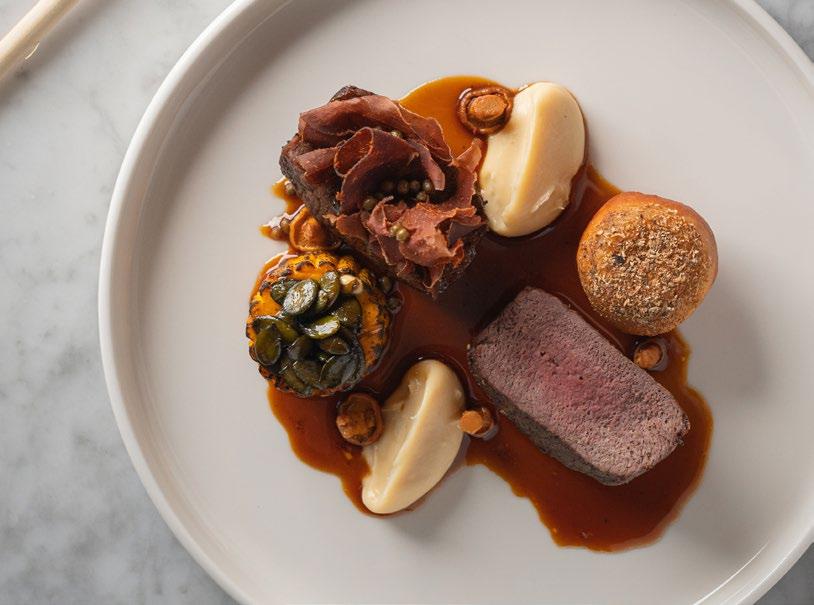
This fabulous restaurant takes you on a culinary adventure through the regional characteristics of Poland, riding the breeze of various seasonal changes and what they bring to the Polish table. Located just west of Poznań’s old town (p.16), Concordia Taste Poznań combines modernity with traditional and old school on many levels. Within a 100+ year-old industrial space, this setting maintains a modern air, while at the same time being cozy and friendly. The same can be said about its menu - Modern variations on traditional flavours from across Poland. This is Polish cuisine at its best, and pondering what part of the country will be visiting your plate is a key part of the experience. It truly is an adventure through Poland’s culinary culture, both geographically and seasonally.
On the latter point, Concordia Taste Poznań serves you the essence of Polish cuisine through the unconventional presentation of their a’la carte menu. Changing with the seasons, it reflects what the fields, orchards and forests of Poland have to offer at that given time, thus guaranteeing the freshness of products and the authenticity of the culinary experience. Concordia’s lunch menu changes on a weekly basis, offering dishes from different regions of the country and inspired by the traditions and tastes of a chosen area of Poland. The inspiration behind the menu is gained first hand - Concordia Taste Poznań’s chef, Adam Adamczak, regularly travels across the country in search of local flavours and dishes, inspirations of which he can then use in his own culinary interpretations. As you would expect, the products and ingredients come from local suppliers, and they are certainly not chosen at random! The restaurant’s list of producers and suppliers has been created during their many culinary excursions across the country. Hundreds of conversations
on crop growing have been had, as have traditional and craft recipes, and many much-enjoyed on-site tastings of fruit yielded on Polish soil. As for Chef Adam Adamczak himself, his resumé brings credibility to what is being served in the restaurant. For starters, he won the Culinary Newcommer of the Year award in 2012, presented by Kuchnia magazine. The prestigious Gaullt & Millau restaurant guidebook identified him as Young Talent in 2015. In 2017, Adamczak was one of only six Poles nominated for The Best Chef Award in 2017, and was also listed among the top 300 chefs worldwide! A year later, he represented Poland at the 2018 Culinary World Cup
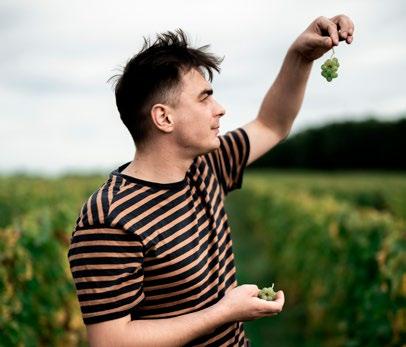
With Concordia’s focus on Polish fresh produce, it should come as no surprise that even the wine list is both locally made and sourced. Non-Poles may be surprised to hear that Poland has a wine industry to speak of. Well, it absolutely does! And it’s growing fast. As Concordia’s experienced sommelier Jacek Kulza writes:
“It is the best time to drink Polish wine. We support what is authentic, we support what is regional. We are the embassy of Polish wines, with the largest selection of Polish wines in the world!”
Jacek Kulza not only makes the selection, he also pairs wines with dishes on the Concordia menu. Indeed, if you are a wine lover, then Concordia has great news for you - Every Thursday, the restaurant organises wine-tasting evenings, during which Kulza presents produce from different vineyards across the country together with representatives of these establishments.
How prestigious! But Concordia Taste’s promotion of Polish wines goes far beyond the regular tasting sessions. The restaurant has come up with Taste the Wine, a project designed specifically to promote Polish wine. In late 2022, a charity dinner was hosted at Concordia, during which local wines from the three participating vineyards (Winnica Zodiak, Winnica Aris, and Winnica Gostchorze) were auctioned off, along with works of renowned Polish artists who contributed the label designs. This was combined with a movie and photo exhibition documenting how these vineyards produce their wine. Most importantly, Kulza wine-tasting selection was skillfully paired with Chef Adamczak’s compositions of flavours and textures - a marriage of the greatest wine and culinary compositions that Poland has to offer! At the time of this article’s writing, Concordia Taste is working on a second edition of the project, in which it plans to faithfully represent the produce of five Polish vineyeards. We feel its important to mention that wine isn’t the only high-proof beverage on the menu. Concordia Taste also draws upon Poland’s reputation for more spirited alcohol, going well beyond the national stereotype of vodka dependence. Fruit liqueurs and mead have always been found on Polish tables, therefore you can expect to find such traditions in Concordia. They even have newer Polish distillery ventures on the list, which include domestically-produced gin and whiskey!
Concordia Taste Poznań is located at ul. Zwierzyniecka 3 (D-7), a short walk west of the city’s historic centre. Qtel. (+48) 609 00 29 64, www.concordiataste.pl. Open 12:30-16:00/17:00-22:00; Fri 12:00-16:00/17:00-23:00; Sat 14:00-23:00; Sun 12:30-18:00. €€€. TU

Travel within Poznań using buses and trams is efficient, fast and cheap; driving a car through the Old Town’s cobbled maze, on the other hand, is not an endeavour we recommend. As such, for visitors the centre of Poznań is best negotiated on foot, or by bike, scooter, public transport or taxi - all of which are explained here. For detailed arrival information about Poznań's airport, and train and bus stations, visit our website.
Enterprising tourists should consider the Poznań City Card - a splendid piece of plastic that entitles the bearer to free admission or discounts to more than 200 places, plus an optional buy-in for free travel on public transport. The card can be purchased from the Tourist Info centres below, as well as the airport and select hotels. 1-day cards cost 49/35zł (44/30zł without transport); 2 days 65/55zł (55/40zł without transport); 3 days 79/65zł (65/48zł without transport). Qwww.poznan.travel.
Tourist Info Offices:
Old Town Market SquareQI-7, Stary Rynek 59/60. Open 09:30-18:00, Sun 09:00-17:00.
Plac KolegiackiQI-7, Pl. Kolegiacki 17. Open May-Sept only, 9:30-18:00, Sun 09:00-17:00.
Poznań is crisscrossed by over one hundred tram and bus lines, including night routes, and represents the most time and cost efficient way to move about town. Due to frequent track work and route changes, however, your best bet for figuring out how to use public transport in Poz is the super-helpful website poznan.jakdojade.pl (mobile app also available), which can tell you exactly how to get from point A to Point B in English. Transport tickets are bought from automated machines found on most buses and trams, as well as at most transport stops, and thankfully you can pay by card (no need for coins!). The galaxy of ticket options are far too complex to review here; you can take it to heart that you won’t be leaving ‘Zone A’ unless you’re travelling far outside of the city-centre, as even Lake Malta is within Zone A. Tickets are timed, and the cheapest option is a not-very-cheap 4zł for only 15mins - which might

only get you 3 or 4 stops. A 45-min ticket for 6zł is the safer bet, but if you plan on travelling often, you may want to consider a 24hr or 48hr ticket. Note that kids under five and adults over 70 ride for free.

Finally, it is extremely important that you validate your ticket by punching it in the ‘kasowniks’ found by the bus/tram exit as soon as you board. Inspectors regularly travel the lines handing out hefty fines, and they aren’t sympathetic to tourists; seriously, riding without a ticket can not only ruin your day, but your entire trip to Poz.
Cruise the town in luxury with Duda-Cars’ MercedesBenz rentals and limousine service. Depending on whether you prefer to put the pedal to the metal yourself or let a carbon-based lifeform do the driving for you, you can either choose ‘rent.me’ and pick from the CLA, GLE Coupe, V-Class premium vans, and more, or go with ‘drive.me’ and get your own Englishspeaking, tuxedo-clad professional chauffeur in an all-black S-Class or V-Class Mercedes.Qul. Ptasia 4, tel. (+48) 885 70 13 52, www.duda-cars.pl/rent-me/. Open 09:00-19:00; Sat 08:00-14:00; closed Sun.
Want your own car, but just for a short while?
Download the Traficar app, find an empty vehicle, scan the QR code, and you’re in. You can leave the car in any legal parking space within their service zone, and you don’t have to pay for gas! Everything is done through their easy-to-use app (in Polish only). In terms of cost versus a taxi, it comes out about the same, but as an alternative to car rental, Traficar is a wonder. You can rent a vehicle for 24 hours for only 59zł and even drop it off in another city where Traficar operates. As such, this is a great option for day and weekend trips, big shopping trips, or simply picking up friends at the airport. Note that you need to have a valid driver’s license that is recognised in PL.Qwww.traficar.pl.
Jakdojade
Poznań’s tram and bus network is relatively easy to use, even for foreigners, but the key to unlocking it is the poznan.jakdojade. pl site and app. The former is a great tool for advance planning, but the app is more practical for figuring out how to get from A to B once you’re out in town. Just type in your starting address (the app does this automatically), destination, departure time, and Jakdojade magically churns out the best method for you to get there. You can also buy and validate tickets in the app.
e-podroznik.pl
This site can also help you get from point A to point B within Poznań, but is really invaluable when it comes to planning the journey to your next destination by bus or train. You can easily search bus and train connections and timetables, compare prices, and even buy tickets in one of eight languages. There’s also a mobile app (Android only).
If you’re already an Uber user (uber.com), you’ll find that the alternative taxi servicewhose free mobile app offers cheap one-tap, no cash, no tip rides from local drivers - has good coverage across Poznań and all of Poland, however there are some drawbacks. Specifically, Uber drivers don’t have the same permissions as regular cabbies and may not be able to take you as close to your destination, or get you there as directly; such is the trade-off for slightly cheaper rates.
Although agitating to some, electric motorised scooters are everywhere across Poznań, and provide a cheap, easy, efficient and environmentally-friendly way to get around. To get started, you need an e-scooter app on your phone (create an account and add your personal data and payment details). The firms with the most current coverage in Poznań are Lime, Bolt and Blinkee. Spare yourself the wrath of locals by using your scooter responsibly; don’t ride through congested areas and when you’ve finished your ride, park it out of the way without blocking the sidewalk.
While Poznań’s Old Town is fairly compact and very walkable, the city as a whole is spread out and features many diverse districts. To this end, in our guide we’ve included sections dedicated to the most important neighbourhoods, walking you through not only the Old Town (p.16) and the even more historical Ostrów Tumski (p.24), but also hip Jeżyce (p.28), understated Łazarz (p.32), chilled-out Lake Malta (p.52), and leafy Citadel Park (p.56). If your time is limited, however, here’s a cheat sheet of the city’s most unmissable sights.

Poz’s glorious Town Hall features an impressive history museum (sadly closed) and mechanical goats who butt heads each day at 12:00 noon.QSee p.18
One of Poznań’s most iconic and impressive historical monuments, this former Jesuit temple is a pink effusion of Baroque extravagance.QSee p.17.

While the Market Square is under construction, this renovated just southeast of it has taken on many of its social and cultural functions.QSee p.17.
Once the pride of Poznań, this royal residence has been rebuilt in a late-medieval style, and includes the Applied Arts Museum, observation decks, and more.QSee p.20
Poznań’s beautiful Old Town Square should really be number one on any best-of list. However, this year there’s a bit of a complication: the square is undergoing renovations scheduled to run until later in 2023 and as such has turned into a loud and messy construction zone. Not quite the picture of Old Town charm we’re used to. While there is still access to all of the square’s restaurants, bars, and museums, exploring the Rynek is not what is used to be, which is why we’re foregoing printing our usual Old Town Square walking tour in this issue, but you’ll still find it online.
A few words about history, though: the Old Town Square was demarcated around 1253, and is apparently the third largest in Poland after the main squares of Kraków and Wrocław. Sadly destroyed during WWII, it was reconstructed in the postwar years - though the Cloth Hall that used to stand in its centre was replaced with a pair of commietastic concrete carbuncles, one of which housed the Arsenał Gallery (now at ul. Szyperska 2p.39). Some of the most compelling monuments situated on the square are the Old Town Hall, an 18th-century police guardhouse turned into the Wielkopolska Uprising Museum (p.45), and the 16th-century Municipal Scales building, originally used to weigh merchandise.
More a palace than a ‘castle,’ Poznań’s fearsome 1910 Zamek offers guided tours and includes museums, restaurants, bars and more.QSee p.23
Also called Cathedral Island, it was on this island that Poznań was founded, and - arguably‘where Poland began’.QSee p.24.
An interactive museum dedicated to the three Poznań-based cryptologists who deciphered the German Enigma cipher during WWII.QSee p.47.
This 19th-century hilltop military fortress was the Nazis’ final stronghold in 1945. Today it’s a leafy 89ha park full of monuments, cemeteries, and museums. QSee p.54
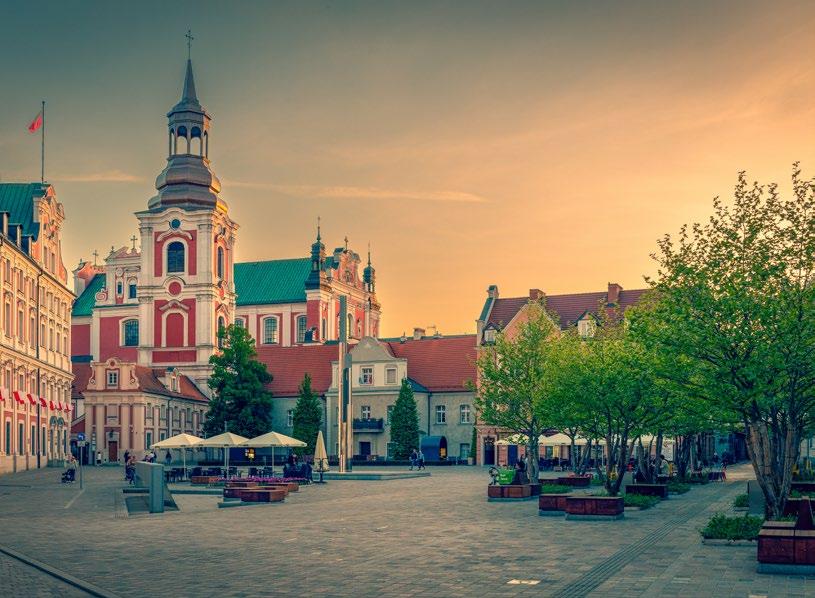
The first place to hit up when in Poznań and the heart of the city - the stunning Old Town deserves a proper, old-fashioned walking tour, which we’re here to provide.

While Poznań is relatively spread out, the bulk of its tourist attractions are located within its historical Old Town and west towards the train tracks, where the Imperial Castle resides. This is the area covered by this walking tour; for places of interest further away from the centre, including Ostrów Tumski and Citadel Park, see relevant sections up ahead. The tour is approximately 2km long and can take as little as half an hour if you dash through it, though for the more inquisitive tourist a few hours seems more likely. Meandering through the Old Town streets is encouraged, as are breaks for coffee, beer, or your libation of choice in the city’s many cosy cafes and beer gardens.
The Parish Church, aka Fara (from the German Pfarre), is one of Poznań’s most impressive historic monuments. Created as a Jesuit temple in the 17th century, it gained the status of ‘lesser basilica’ in 2010 thanks to Pope Benedict XVI. The official name of this establishment is actually quite a mouthful: the Basilica of Our Lady of Perpetual Help, Mary Magdalene, and St. Stanislaus, which is why both we and the locals prefer the much simpler Fara. The church boasts an interior by a veritable who’s who of Roman Baroque artists, with some fine period ornamentation found in the chapels of the Holy Cross (which features a 16th-century crucifix), and the Virgin Mary (which has a precious copy of the painting The Mother of God of Incessant Help). Organ concerts played on an instrument dating from 1876 take place on Saturdays at 12:15. Don't miss the basilica’s inner courtyard, a peaceful spot which is usually hosting some outdoor exhibition or other, From there, it's only a few steps to Chopin Park QI-7, ul. Gołębia 1, tel. (+48) 61 852 69 50, www.fara. archpoznan.pl. Open 06:00-19:30.
Newly reopened after renovations, this expanded public square will absorb some of the social and cultural functions of Poznań’s market square, while the latter is under construction. Formerly a car park in front of Poznań City Hall - located in the lovely Baroque buildings of the former Jesuit College which give this square its name - the resurfaced square now hosts numerous benches, trees, a fountain and the gardens of several bars and restaurants. Until the early 1800s the Collegiate Church of St. Mary Magdalene stood in this place. With an almost-100m tower, the church was one of the largest in Poland
when it was destroyed by fire in 1773 and the ruins eventually pulled down by the Prussians. Today the square’s history is acknowledged by a tall monument at its centre called the ‘Clock of History’ and glass windows in the surface of the square showing the church foundations and artefacts below. QI-7.
Although the market square is currently a quagmire of construction, you still have to take a look at Poznań’s most iconic architectural monuments. From the east side of the Rynek you’ll have a good view on the highly photogenic, technicolor row of townhouses known as the ‘Budnicy Houses.’ Originally called “herring shops” (budy śledziowe), these colourful tenements were home to merchants, and their ground-floor arcades held fish, candle, torch, and salt stands. They were later renamed to Budnicy Houses (domki budnicze) in honour of a class of merchants known as Budnicy, whose headquarters used to operate at no. 117. Look closely and you’ll see their unique coat of arms on the facade: three palm trees and a herring.QI-7, Stary Rynek.
Housed in an old brewery dating from 1844, the award-winning Stary Browar complex has been dubbed an art, leisure, and shopping extravaganza, and its success a sign of Poznań’s economic renaissance. Its opening in 2003 also marked a successful move away from out-oftown developments, and a new trend for innercity regeneration projects. Originally home to the Huggerów Brewery, the building produced beer until 1980, then mineral water until 1998, when it was bought by the Fortis Group and a $66 million USD investment transformed it into the shopping and entertainment Mecca it is today. Home to tonnes of art and outstanding design details, Stary Browar also features a cinema, fitness club, dozens of restaurants, cafes, and bars, and over 200 retail spaces, in which you’ll find both name brands and popular chain stores.QG-9, ul. Półwiejska 42, tel. (+48) 61 859 60 50, www.starybrowar5050.com. Open 09:00-21:00; Fri, Sat 09:00-22:00; Sun 10:0020:00.
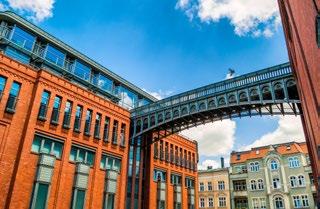

First erected in the early 14th century, Poznań’s glorious Town Hall (Ratusz) really flowered in mid1500s when Italian architect Giovanni Quadro of Lugano added the Renaissance loggia, attic, and classical tower, earning the structure acclaim as ‘the most beautiful building north of the Alps.’ Unfortunately a catalogue of historic disastersincluding a 1675 fire, 1725 hurricane and WWII bomb damage - have resulted in the sad reality that today little of the original structure actually remains, though it has been faithfully rebuilt to retain its status as the city’s showpiece.
Today the Old Town Hall houses the Historical Museum of Poznań - currently closed for renovations - whose collection encompasses exhibits from the 10th century till the present day. The biggest draw is the Great Entrance Hall with its elaborately decorated vault, supported by two huge pillars. Directly outside the Town Hall is the original whipping post (Pranger), dating from 1535, with a recently repaired figure of Poz’s executioner standing on top.
Crowds gather outside the Town Hall each day to witness two mechanical billy goats emerge from a door above the clock at precisely 12:00 (once the Old Town Square rennovations are completed, also at 15:00) and proceed to butt heads twelve times. Simultaneously, a trumpeter plays the town’s traditional bugle call from a balcony. The bugle call (hejnał) dates back at least to the 15th century, and the goats have been ramming heads 1551. Replaced and restored over the years, the present pair have been bludgeoning each other since 1954. Of course there’s a half-baked legend to go along with them: When the clock was completed in 1511, the governor of the Poznań province was invited for the unveiling. The hapless cook preparing the celebratory feast burnt the venison, so he went out and managed to steal a pair of goats to serve instead. Alas, the goats escaped and traipsed up to the top of City Hall, where the governor saw them butting heads and decreed they be added to the clock. The rest, as they say, is history - much like the cook, who was likely tied to the whipping post and given a bloody good thrashing.QI-7, Stary Rynek 1, tel. (+48) 61 856 81 93, www.mnp.art.pl.
Originally called ul. Sukiennicza (Cloth Hall Street), this unassuming lane became the de facto centre of Jewish life as early as the 13th century, when the first Jewish settlers in Poznań were given plots of land here. Eventually renamed Judenstrasse and later ul. Żydowska (both meaning simply Jewish Street), it retained this
character until the tragedy of the Holocaust. While here, keep an eye out for the former Salomon Beniamin Latz Home for the Elderly and Infirm (ul. Żydowska 15/18). Established in 1908 after the Latz foundation swapped properties with the Jewish Community, the home took the place of three synagogues that used to exist at the address; meanwhile, the foundation’s former hospital at ul. Wroniecka was torn down to make room for the New Synagogue. If you manage to get in (the building is currently residential), traces of the in-house synagogue’s balcony can be seen in the stairwell. Another building of note is the former Jewish Library at ul. Żydowska 32, founded in 1904.

Consecrated on September 5, 1907, the New Synagogue was once a much more lavish structure. Designed by Berlin architects Cremer & Wolfenstein at a cost of 1 million marks (to put things in perspective, the cost of the Imperial Castle came to 5 million), the synagogue boasted a floor plan based on the Greek cross, space for 1,200 worshippers, and originally included a copper-plated dome. Following the outbreak of WWII the building was commandeered by the Nazis and redeveloped into a swimming pool and rehabilitation centre for Wehrmacht soldiers. After the war the synagogue continued to function as a municipal pool - leading some to jokingly brand it the ‘swimagogue’ - until the poor state of the building forced its closure. Returned to the Jewish community in 2002, a gallery was opened inside, sporadically hosting free exhibits. Though plan were drafted to adapt it into a Jewish community centre complete with prayer halls, kosher restaurant, and conference facilities, the small problem of raising the millions of złoty necessary proved too large an obstacle. More recently, plans have been made to convert the building into a commemorative museum, with or without an upscale hotel attached, but for now the synagogue continues to stand empty.QI-6, ul. Wroniecka 17.

As a typical central European city, Poznań of course was once snugly encircled by city walls and a moat, with four gates guarding the passage into the narrow streets. Along the walls rose a number of defensive towers named after the guilds who were normally responsible for manning them: there was the Wheelwright Tower, Butcher Tower, and Cloth Tower, to name a few. Originally built sometime in the 13th century, the fortifications were unfortunately largely destroyed during the Swedish Deluge in the 17th century and later invasions of the city, and what was left was almost completely taken apart by the Prussians in the 19th and early 20th centuries to make room for new building projects. One of those was a rather splendid neo-Gothic fire station, which - lovingly refurbished - survives to this day at ul. Masztalarska 3. Passing through its courtyard is a stretch of reconstructed city wall and two rebuilt towers: Baszta Strażacka (Firefighter Tower, not the original name) and Baszta Katarzynek, once part of a convent inhabited by Dominican nuns (then known as ‘Katarzynki’). Part of a third tower, Baszta Armatnia (Artillery Tower) stands on the Roman Wilhelmi Square. QH-6, Between Skwer Rabbina Akiwy Egera & Skwer Romana Wilhelmiego.
Every European city worth its salt has a castle, and Poznań actually has two. Indeed, the 20th-century ‘Zamek’ west of the Old Town is neither Poznań’s oldest, nor most important castle. Just one block west of the market square you’ll find Góra Przemysła, crowned by Poznań’s former Royal Castle. Once the pride of Poznań, the original construction was begun approximately 1249 by Przemysł I - Duke of the Piast dynasty who had chosen Poz as his capital.
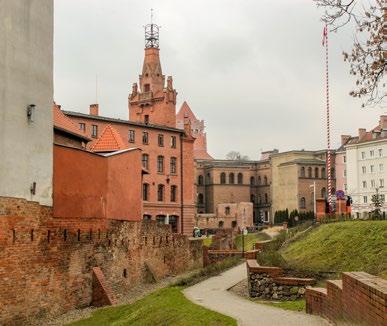
Work on the royal residence was continued by his son, then expanded upon and updated over the years by subsequent rulers until its fortunes took a serious turn for the worse in early 18th century when it was sacked several times in quick succession by the Swedes, the Russians, and then disgruntled nobles. Governor General Kazimierz Raczyński restored the medieval buildings and created a state archive here in 1783 - a function it would serve until WWII. During the Siege of 1945, the castle had the misfortune of being in the line of fire with the Nazi stronghold on Citadel Hill and that was that. In 1959, the decision was taken to rebuild Raczyński’s contribution to the hill, which became the home of the Applied Arts Museum. Here, a fascinating 2000-piece exhibition of furniture, fabrics, ceramics, glassware, weaponry, and clothing from around the world can be seen. Elsewhere, the you can find a historical exhibit about the castle and Przemysł II on the ground floor, in addition to a number of other curious oddities such as box with 18th century smells and tiny glass coffin with Napoleon’s hair. Thanks to more recent reconstructions, a 43m tower can be climbed for fine views of the Old Town.QH-7, Góra Przemysła, tel. (+48) 61 856 80 75, www.mnp.art.pl/oddzialy/muzeumsztuk-uzytkowych. Open Hours: Tues, Wed 10:00-16:00; Thurs 10:00-18:00; Fri 10:00-20:00; Sat, Sun 10:00-17:00; closed Mon. Admission 20/13zł. Tue free.
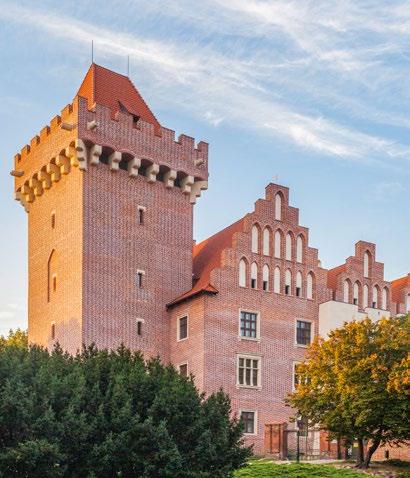

This wide street, home to the Imperial Castle and the Music Academy, takes its name from the unassuming St. Martin’s Church located near its eastern end (H-8, ul. Św. Marcin 13). This house of worship originally stood in a settlement outside the walls of Poznań beginning around the 12th century, but was brought inside the boundaries at the end of the 18th century.
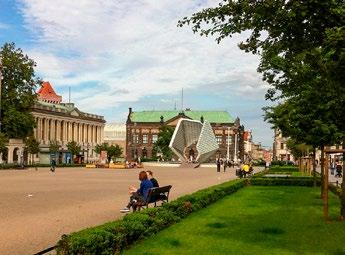
One of Poznań’s younger traditions, started back in 1994, is the celebration of St. Martin’s name day on November 11th. The festival includes a high mass in St. Martin’s Church, a colourful parade up ul. Św. Marcin to the square in front of the Imperial Castle, special exhibitions, concerts, and performances. A key part of the celebrations are St. Martin’s croissants (rogale świętomarcińskie) - delicious and highly calorific pastries filled with a poppy seed and almond paste (more on p.57).

What else can you see on St. Martin? The middle part of the street is dominated by a relic from the PRL era, the ‘Alphas’. Built in the years 1965–1972 and widely considered the buildings that ruined ul. Święty Marcin, these five 12-storey high-rises are a modernist architectural nightmare, more due to their poor workmanship and decades of neglect than the actual design. Recently, the stretch of ul. Św. Marcin along the Alphas underwent a major overhaul, and is now a more welcoming, pedestrian-oriented area with outdoor art installations and a modest bit of greenery. The Alphas too are set for renovation, and we‘re keeping our fingers crossed for the results.
Believe it or not, ‘Freedom Square’ was once the heart of the city - a favourite spot of the upper classes for strolls and coffee. Originally named Wilhelmsplatz (William’s Square) in honour of King Frederick William III of Prussia, it was demarcated by the city’s new Prussian authorities at the very end of the 18th century, and it was here that large military parades were held. In the years leading up to the Great War, the square underwent numerous changes, becoming encircled with buildings designed according to the latest architectural fashion; a few examples are the Raczyński Library at no. 19, the Provincial Museum in Posen (now a National Museum building, Al. Marcinkowskiego 9), and Bazar Hotel (Al. Marcinkowskiego 10 (see p.45 for more info on the role it played in the Wielkopolska Uprising). A monument to the 1866 Prusso-Austrian Battle of Nachod popped up, as did a figure of King Wilhelm III. These were torn down triumphantly when Poznań returned to Polish hands at the end of WWI, and the square also was first given its current name. After 20 blissful interwar years, during which the square functioned as the cultural centre of Poznań, the square was dug open with trenches in preparation for WWII, and soon German forces once again marched in (It would be renamed Wilhelmsplatz during the occupation). Back to Plac Wolności after the war, the restored square became a go-to not for state parades, but for protests and demonstrations! In 2012, its most recognizable landmark was unveiled - the Freedom Fountain (Fontanna Wolności), a geometric structure with two 10-metre wings (or sails) made out of glass. QG/H-7.
At the western end of ul. Grudnia (A-2), the imposing Okrąglak (Rotunda) presides over a four-point intersection. This cylindrical marvel is one of Poznań’s defining icons and has been a listed building since 2003. Constructed between 1948 and 1954 this beast is a leading example of Polish modernism, built to a blueprint
by Marek Leykam. This 8-floor masterpiece once housed Poznań’s top department store, and it was here that, during the lean years of communism locals, would queue to buy ‘luxury’ products unavailable elsewhere. After years of abject neglect, in 2011-2012 the Okrąglak was restored and converted into 51,000 square metres of A-class office space.QF-7, ul. Mielżyńskiego 14, www.okraglakpoznan.pl.
More a palace than a ‘castle,’ work began on Poznań’s fearsome ‘Zamek’ in 1905 to serve as the provincial residence of Kaiser Wilhelm II. Designed in the neoRomanesque style by Franz Schwechten, the west wing held Wilhelm’s living quarters, the east wing his immaculate throne room, with the northern part of the complex consisting of service rooms and beautiful gardens based on the Alhambra’s Courtyard of the Lions. The Kaiser got the keys in 1910 but didn’t stay long before WWI and the following Wielkopolska Uprising 1918-1919 resulted in a Polish Poznań once again. Between the wars, the Zamek became the seat of Poznań University, before the Third Reich swooped in and Albert Speer, Hitler’s pet architect, transformed the tower chapel into the Fuehrer’s office (though Hitler would never step foot in Poz), and the second floor into the residence of Arthur Greiser, the Nazi governor of the district. Badly damaged during the Soviet ‘liberation’, there was later a post-war campaign to have the structure bulldozed. Ultimately, a compromise was met by reducing the principal tower to a third of its original height. Briefly used by the University, it was the seat of local government until 1962, when the Zamek began to operate as a cultural centre. Known as Centrum Kultury Zamek (Castle Cultural Centre), this is one of the biggest cultural organisations in the country, hosting hundreds of exhibits, concerts, theatre performances, film screenings, festivals and other events in its palatial halls each year. The basement houses the 1956 Uprising Museum (p.45), and throughout the large complex visitors will find several restaurants, cafes, and bars. For more, audioguides and app guides can be rented for 20/17zł.QF-7, ul. Św. Marcin 80/82, tel. (+48) 61 646 52 60, www.ckzamek.pl. Open 12:00-20:00; closed Mon. Free admission without tour.
The Old Town tour might be over, but there’s lots more to discover in Poz. Feel like walking on?
Turn east at the Imperial Castle to walk down the length of St. Martin Street (p.22), a place associated with Poznań’s favourite saint and - by extension - the city’s signature croissants, or turn west to follow all the local hipsters to the coolest district in town, Jeżyce (p.28).
HOTEL & SPA, a member of Radisson Individuals

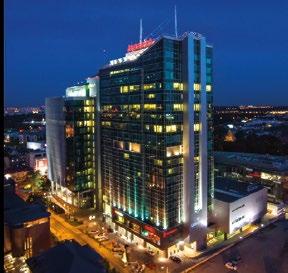
172 rooms and apartments
Restaurant Flavoria with exquisite cuisine

Banqueting and conference rooms up to 600 Guests
Wellness Club & Pool
Underground parking
Just north-east of the centre of Poznań sits Ostrów Tumski (Cathedral Island) - the island where Poznań was founded, and “where Poland began” in the words of Pope John Paul II.
According to the prolific legend, three Slav brothers known as Lech, Czech and Rus met on this tiny island after not seeing each other for many years. To commemorate their reunion the brothers named the place ‘Poznać,’ after the Polish word for ‘to meet.’ From there the island thrived, with a castle erected in the 9th century and Ostrów Tumski becoming a major centre of the Piast state. More than a millennium ago one of Poland’s first rulers, Mieszko I, ushered the country into Catholicism here and soon after the first bishopric was established in 968.
The first iteration of the Cathedral of Poznań was built in the second half of the 10th century, and in the island’s thousand-year history it has been home to kings and bishops alike. Originally fortified in the 16th century and augmented by the Prussians in the 19th century,
some of these fortifications survive to this day, including Cathedral Lock (now home to the Galeria Śluzna exhibition space). In more recent times the Communists showed their disdain for the Catholic Church’s heavy presence in Poznań by building a road across the island that bisected the Archbishop’s garden.
A trip to Ostrów Tumski not only makes a peaceful respite bustle of Poznań’s city centre, but also serves as an important crash course on early Polish history and Poznań’s role in the country’s birth as a nation. Taking that task on as its very mission, in fact, is the Porta Posnania Centre, which straddles the river (with its own bridge) between Ostrów Tumski and Śródka, and should be considered the mandatory starting point for all visitors before carrying on to the magnificent Poznań Cathedral itself.
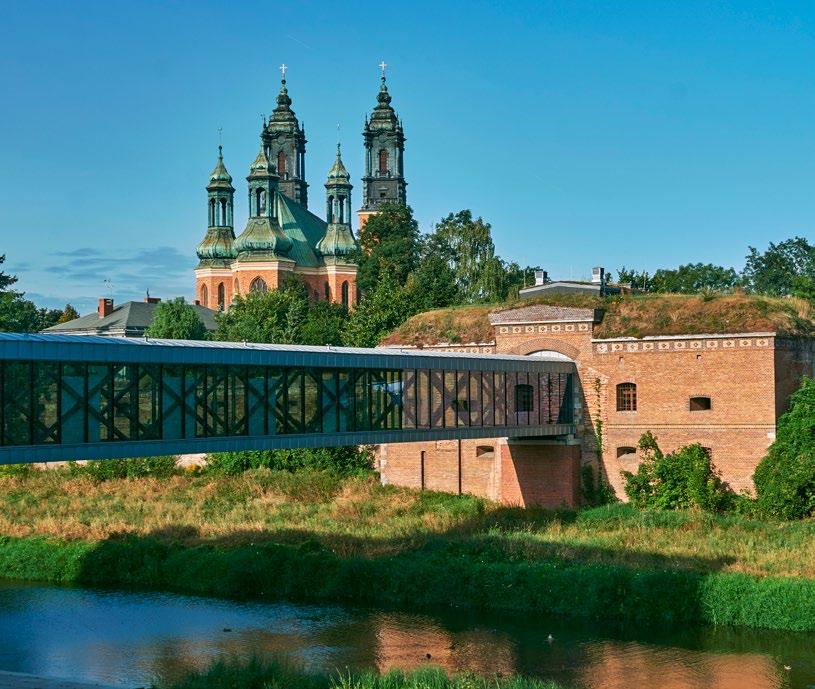
Opened in early 2014, this modern culture complex symbolically connects Poznań’s two oldest districts - Ostrów Tumski and Śródka - via a covered ‘skywalk’ bridge between the main exhibition building and the Cathedral Lock - a restored section of the former Prussian river fortifications. The main building is actually on the Śródka side of the Cybina River, and presents the fascinating history of the area from medieval times to the modern day, with a dollop of PolishCatholic propaganda, via a rather gimmicky combo of audioguide and interactive multimedia displays.
The touring route concludes by leading visitors across the ‘skywalk’ straight into Ostrów Tumski itself, making this the ideal starting point for exploring the district. Audioguides are available in English, German, French, Spanish, Czech, Russian, and Ukrainian, with three specially designed audiotour routes - one for individuals, one for groups, and one for families - that make the experience worthwhile for everyone, especially kids. Topping it off is a souvenir shop and a lovely rooftop terrace that offers unique views of Poznań Cathedral and the surrounding area. QL-6, ul. Gdańska 2, tel. (+48) 61 647 76 34, www.bramapoznania.pl. Open 09:00-18:00; Sat, Sun 10:00-19:00; closed Mon. 1st entry to exhibits at 10:00, weekends 10:20; last entry 1hr before closing. Admission 28/17zł; Group tickets (min. 10 people) 20zł per person. U
Located in Cathedral Lock (Śluzna Katedralna), part of a 19th-century system of Prussian fortifications around Poznań, this new exhibition space is technically part of Porta Poznania - to which it is connected over the Cybina River by the wonderful skywalk - but operates independently. Temporary exhibits tell the story of how contemporary Poznań has been shaped by its past, focusing on three thematic pillars - city’s people, the urban landscape and natural environment. Unlike the rest of Porta Posnania, entry to the exhibits is free and there is also an entrance from ul. Dziekańska. Check online to see what’s on during your visit.QL-6, ul. Dziekańska 2, tel. (+48) 61 647 76 31, www.galeriasluza. pl. Open daily 9:00-17:00; Sat, Sun 10:00-18:00; closed Mon. 1st entry to exhibits at 10:00, weekends 10:20; last entry 1hr before closing. Admission free. U

The creation of the Porta Posnania Interactive Heritage Centre - the gate to Ostrów Tumskimeant that the logical starting point for exploring the Cathedral Island has shifted from the Old Town side to Śródka. Good thing, too, since this ancient and irresistibly cute neighbourhood is badly underrated.
Once its own town, Śródka was named in honour of its weekly Wednesday market (‘środa’ means ‘Wednesday’ in Polish), and records suggest the small enclave had urban features and its own autonomous government as early as the mid1200s. The presence of Dominican monks, along with the regular market, gave Śródka prominence in the area, which unfortunately didn’t last long; the monks picked up and moved across the Warta River, and Przemysł II (who subsequently became King of Poland) turned the city over to the control of the Bishopric in the 13th century. Suddenly reduced to the role of supplier to Ostrów Tumski, Śródka would continue to slide in prominence as the nearby city of Poznań grew.
Śródka had a revitalization of sorts in the 17th century when orders of Phillippines and Reformists swept in and established churches and residences in the city, yet it was nonetheless absorbed into Poznań in 1800. During Prussian times the city was part of a fortified zone that didn’t improve its fate. During World War II much of the city’s centre at Rynek Śródecki was destroyed, and the arrival of the People’s Republic of Poland, which slapped a garish highway across the Archbishop’s gardens and Ostrów Tumski, didn’t improve the area either. Luckily, though, in the 21st century Śródka is slowly experiencing a noticeable revitalization.


The most stunning site on Ostrów Tumski is certainly Peter & Paul Cathedral, more commonly called ‘Poznań Cathedral,’ which ‘Cathedral Island’ takes its name from. Originally erected way, way back in 968, this was the first cathedral in Poland, and has had a storied history. As it was razed, rebuilt, and remodelled numerous times over the centuries, each resulted in the addition of a new architectural style: a 1622 fire led to a Baroque finish, while a 1722 fire ushered in a change to neo-Classicism. During the 1945 battle to liberate Poznań, 65 percent of the Cathedral again burned down, exposing the building’s buried Gothic elements and leading to its restoration in the style visitors see today.
The interior is a trove of sacral and historical treasures, surrounded by twelve different chapels, including the Chapel of the Holy Sacrament, which has several outstanding examples of Renaissance art (the tombstones of the Górka family and Bishop Benedykt Izbieński, to be specific) and the Baroque altar houses a miraculous crucifix brought to the Cathedral from the former Wrocławska town gate. The Golden Chapel was designed as the mausoleum of the first Polish rulers and houses the sarcophagi of Duke Mieszko I and his son, King Bolesław Chrobry; the two are also depicted in a bronze monument together, above which is a painting by January Suchodolski showing Mieszko I, the instigator of Catholicism in Poland, destroying pagan idols. The chapel is indeed thoroughly golden, but to fully admire the glitz you must drop a coin into an absurd contraption, whereupon the illumination will come
on. The eye-catching high altar at the centre of the Cathedral is a 14th/15th polyptych depicting Our Lady surrounded by 14 female saints, while the outer wings feature eight paintings depicting the Passion of the Christ. The Cathedral’s lavish Baroque pulpit is equally stunning and dates to 1720. Also worth noting are the Cathedral’s five Gothic and early Renaissance bronze tomb slabs, which originated at the famed Nuremburg workshop of Herman and Peter Vischer. The slabs were originally on the Cathedral floor to cover the entrances to tombs, but were later mounted on pillars and chapel walls. Stolen during the war, the slabs were returned to Poznań in 1993 and are back on display.
Visit the vestry to request entry to the crypt, where you’ll see evidence of the pre-Romanesque and Romanesque versions of the Cathedral, and a 10th century baptismal font most likely used to baptise the first Polish sovereign and his subjects. Excavations here also unearthed two tombs, most likely of the first Polish monarchs Mieszko I and King Bolesław Chrobry. The second crypt houses an exhibition of artefacts found during the excavation, and it also leads to the crypt of the Poznań archbishops. Be aware that while the lights in the crypt work for free (no coins!), they are motion-activated, so if you stand and look too long, you’ll suddenly end up in the dark.QK-6, Ostrów Tumski 17, tel. (+48) 61 852 96 42, www.katedra. archpoznan.pl. Open 09:00-17:00. Admission 6/5zł.
This small Gothic church was built in 1432-1448 and is modelled on the West Pomeranian building style, with a three-nave hall, star vaulting, and polychromatic decorations. The altar was designed by Wacław Taranczewski in 1954. The adjoining building with the crowstep gables is a Late Gothic Psalteria, dating to 1518, which contained flats for the clergy.QK-6, ul. Panny Marii, tel. (+48) 61 852 96 42, www.katedra.archpoznan.pl.
Adjacent to the Cathedral is the large Lubrański Academy building, once home to Bishop Jan Lubrański’s institute of higher learning and today the Museum of the Archdiocese. The first floor is devoted to temporary exhibits, while the next two floors are filled with all manner of religious art and relics, including the Sword of Saint Peter, numerous statues and paintings of the Madonna, Jesus, and various saints, plus well-preserved robes and heavily-bejewelled rings from Poznan’s long line-up of bishops. QK-6, ul. Lubrańskiego 1, tel. (+48) 61 852 61 95, www.muzeum.poznan.pl. Open 11:00-16:00; Sat 11:00-15:00; closed Mon, Sun. Sun (MaySeptember): 11:00 - 15:00 Last visitors enter half an hour before closing. Admission 20/15zł.

Genius Loci gives a different view on Poznań’s medieval genesis by unearthing, reconstructing, and offering insight into the lives of those early individuals who inhabited the island one thousand years ago. Explore multimedia displays and documentary films, and brave the glass walkways while peering down at the city’s original walls and embankments. The audioguide (included in the price) comes in Polish, English, German, Russian, and French and helps explain how Poznań took shape centuries ago.QK-6, ul. Ks. I. Posadzego 3, tel. (+48) 61 852 21 67, www.rezerwat. muzarp.poznan.pl. Open 10:00-16:00; Fri, Sat 10:0018:00; Sun 10:00-15:00; closed Mon. The last entry to the exhibition is possible no later than 30 minutes before the closing of the Reserve. Admission 15/10zł, Sun free. U
Though very small, Śródka has a surprising number of good restaurants. Here are our top two!
The widest selection of regional Wielkopolska dishes, including blood soup, grey dumplings, and the hyćka elderflower cordial..QL-6, Rynek Śródecki 17.
This hip corner bistro in Śródka turns pierogi into an art by baking their dumplings and using creative fillings you won’t find elsewhere.QL-6, ul. Śródka 1.
A mix of architectural styles and street art in Jeżyce
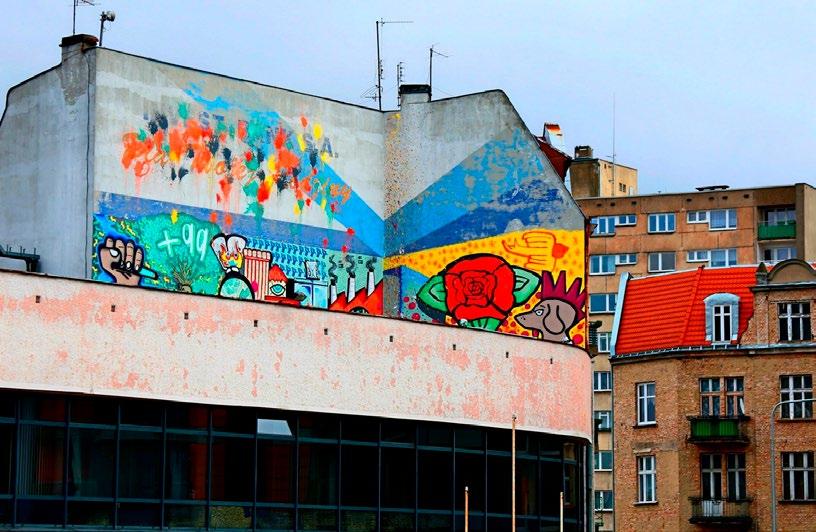
Grungy and hip, Jeżyce serves as an alternative to the Old Town, offering good eats, cool street art, and a few historical attractions.
Almost all of Poland’s major cities seem to have a gravitational centre of charm in the beloved ‘Old Town’ of each, and Poznań is no different. However, after a millennia of business-as-usual, the old school charisma will eventually be challenged by a grungier, cheaper and generally younger community somewhere further out. In Poznań, this area is Jeżyce - a happening neighbourhood to the west of the city centre and well-deserving of the ‘cool’ adjective! In the 21st century, Poznań’s increasingly hipster and food-obsessed district might not be much of a looker, but there’s plenty brewing under the surface if you’re interested in doing some more alternative sightseeing.
First mentioned all the way back in 1253 and believed to have been named after some guy called Jerzy (George), nothing would really happen here until the mid 19th century. The ‘foundation’ of the original village can be observed along today’s ul. Kościelna, which today functions like the district’s high street. The city’s first railway station was built here in 1848; however, it was relocated a couple of decades later to where it is now. On the older site, the city’s first zoo was founded in 1871. Those who are against animals in captivity can at least appreciate the old pavilion buildings and green parklands, though the site’s main purpose is hard to ignore!
Further development in the early 20th century saw townhouses replacing farming infrastructure and the grounds of the all-important Botanical Gardens. If you look at the district on Google Maps, you’ll see that it is squarely-defined by the limits of the major roads to the west and south and the old fortifications and railway line to the north and east. These strict borders were part of a decision made in the 1890s to place limits on the district, which then defined Jeżyce Market Square as its centre. However, Jeżyce is typically associated with covering at least another couple of square kilometres to the west.
In addition to the neighbourhood’s trendy gastro points (see our favourites in the Eat & Drink box), Jeżyce is also a place to sample culture. Most notably, keep an eye on the schedule at the New Theatre (E-6, teatrnowy.pl) and Rialto Cinema (C-6, kinorialto.poznan.pl).
Exceedingly easy to get to from the centre, take trams 2, 17 or 18. The ‘Rynek Jeżycki’ stop is the logical place to start, which puts you right on the neighbourhood’s market square, and at the bottom of ul. Kościelna - the district’s high street.
For many, Jeżyce is synonymous with its market square, wherea daily open-air market still functions (open 06:00-20:00; closed Sun). Laid out in 1891, this was once one of the city’s finest public squares, as evidenced by the faded glory of some of the intricate Art Nouveau facades on the tenement buildings that surround it. Lately the area has been going through a bit of a resurgence, and though the market itself may be a bit tatty and you can hardly expect English to be spoken or understood, the 400 merchant stalls here are still a good place to pick up fresh fruit and vegetables, as well as peruse clothing and other random goods you might be wiser not to take home. You certainly won’t beat the prices.QC-6, Rynek Jeżycki.

Running north from Rynek Jeżycki, this is a good street to explore and get a vibe for the neighbourhood, as it features many cafes, restaurants, ice cream parlours and divey student bars, as well as several large murals. ‘Church Street’ takes its name from the Church of the Sacred Heart of Jesus & St. Florian - a red-brick beauty that squats on the southern end of the road and was consecrated in 1911.
Jeżyce is all about those hipster eats, and you might do well to just wander around and see what catches your eye. That being said, here are a few of our favourite places to dine.
ALEkosmos
Awesome breakfast and coffee spot featuring a lush tangle of houseplants planted in a bathtub. See p.58 QB-6, ul. Jackowskiego 43.
Falla
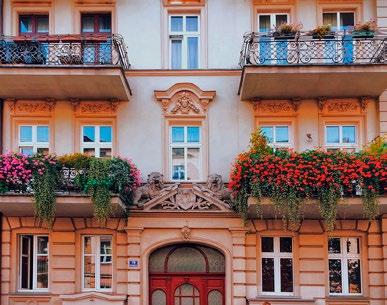
This hip Jeżyce bistro turns out falafel bowls so delicious and beautifully presented it’ll make you want to weep for joy. See p.64 QB-6, ul. Wawrzyniaka 19.
U
A delightful hole-in-the-wall serving authentic Kyrgyz cuisine. See p.65.QC-6, ul. Szamarzewskiego 8.
Wypas
Widely regarded as Poz’s best vegan haunt, this underground restaurant is known for heaping portions of international dishes.QB-6, ul. Jackowskiego 38.
and sink. After the war the shelter was used to store municipal waste, and later as a homeless shelter. Since 2019 it has been maintained by a passionate group of locals who have installed artefacts and exhibits about the site’s history and it is open to the public as a small museum every Sunday from 14:00-19:00; to inquire about visiting other times email robmenesiak@gmail.com.QC/D-4/5.
Further on near ul. Kościelna 50 you’ll find the entrance to an underground WWII-era air raid shelter. Built by the Nazis in 1943, this was a civilian shelter that could hold up to 150 people and was for Germans only; Polish residents of Poznań were not admitted. As it happens, Poznań was the target of three Allied air raids, but the air raid alarm was sounded on at least 130 occasions, during which Germans living in the tenements nearby would pack into this underground bunker, which was lit with kerosene and carbine lamps and included a toilet

One of Poland’s oldest zoos, the Old Zoo dates to 1871 and still has some picturesque old pavilions, but most of the critters have been carted off to the New Zoo on the other side of the city, and the Old Zoo has largely been reshaped as a public park. There is, however, a modern Reptile House here, where you can watch Komodo dragons strutting their stuff, pythons slithering, and caimans splashing around. It’s worth the admission price, and enjoyable to visit without the exhaustion and crowds of the New Zoo.
QD-7, ul. Zwierzyniecka 19, tel. (+48) 61 848 08 47, www.zoo.poznan.pl. Open 09:00-19:00. Admission free; 8/6zł for the Reptile House.
This lush green district just north of Jeżyce might be small, but it is a lovely place for a walk if you do find yourself in this area. Originally its own village located outside of Poznań, Sołacz took on its current shape and character at the beginning of the 20th century, when architect and urban planner Josef Stübben oversaw its evolution into a luxury villa district. The neighbourhood is bisected by the Bogdanka Stream, running through two parks: Park Sołacki (B/C-2/3) and Park Adama Wodziczki (D/E-3). Park Sołacki is the bigger of the two and occupied by two ponds in addition to a 1911 pavilion housing the Port Sołacz restaurant (C-3). With no fence hemming it in you’re free to wander the more than 14 hectares it covers and enjoy the peace and quiet anytime you like. Just steps away is a 4-hectare arboretum with over 800 kids of trees (A-2, ul. Wojska Polskiego 71E; open 10:00-18:00 Mon-Fri), and, beyond that, the peaceful Lake Rusałka (p.50).

Located just below the southeast shore of Lake Rusałka, Poznań’s lovely Botanical Garden boasts a vast 22 hectares and over 7,000 varieties of plants from various climates and ecosystems. Free to visit and open year-round, the garden is a recreational and educational park owned by the Adam Mickiewicz University in Poznań, and its history dates back to 1922 when it was only a 6 hectare plot. The park includes several greenhouses (not open to the public), a large Alpinarium, a snazzy two-storey exhibition pavilion with an art gallery and cafe, several enormous standing stones that look like they took great trouble to bring here, and a lovely ballerina fountain designed by Margaret Węcławska - a graduate of the Poz Academy of Fine Arts. Worth visiting on a nice day, though note that it is quite popular on weekends. To get here, take tram no. 17 from Plac Ratajskiego to Ogrody, or consider renting a city bike - it’s a 4 km trip from the Old Town.Qul. Dąbrowskiego 165 (Ogrody), tel. (+48) 61 829 20 13, www.obuam.robia.pl. Open 09:00-20:00. Admission free. UL
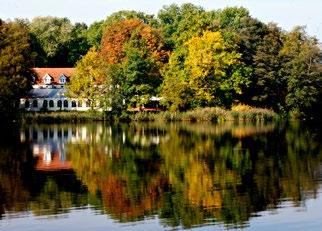


Filled with 19th-20th century townhouses and villas in addition to several parks, Łazarz has a distinct community feel with an undercurrent grungy vibe. Though it might at first feel largely residential, the district is home to many of Poznań’s attractions, including the famed International Fair grounds, the Palm House, a commie-tastic and highly instagrammable sporting arena (Hala Arena), and refurbished light cavalry barracks (City Park / Stare Koszary) now housing an assortment of top-notch restaurants.
The settlement called Łazarz (Lazarus) was founded in the 15th or 16th century on land previously owned by the Order of St. Lazarus, a Catholic formation known for taking care of lepers. In the 1700s it welcomed an influx of Bambers and - a century later - a wave of industrialization with the creation of factories and an electrical plant. In April 1900 Łazarz was integrated into Poznań along with Jeżyce, Wilda, and Górczyn, sparking a period of rapid development resulting in a fantastic array of art noveau, modernist, neo-Classicist and Swiss chalet style architecture. Mercifully spared during WWII, Łazarz served as the city’s administrative centre for a short time, and it continued to carry on a peaceful existence in the postwar years.
Occupying a sprawling plot of land just west of the train station, the Poznań Congress Center is home to the Poznań International Trade Fairs (see p.36), the tradition of which dates back to 1921. Each year sees 60+ trade fair events - everything from welding to horticulture and from logistics to beach fashion - hosted throughout this 150,000m2 space consisting of 16 air-conditioned halls and 77 modern conference rooms.QD-9, ul. Głogowska 14, tel. (+48) 61 869 20 00, www.pcc.mtp.pl.
Tragically, the Jewish Cemetery on ul. Głogowska, founded in 1804 after Prussian authorities liquidated a necropolis located on what is now Plac Wolności, was fully razed by the Nazis during WWII, with most of the grounds subsequently incorporated into the Poznań International Fair. In 2007-2008, however, a small part of the cemetery was reconstructed in the only open space available - a small courtyard at ul. Głogowska 26A. The commemorative site comprises modern tombstones of Rabbi Akiva Eger, his wife and son, and two other Poznań rabbis. Entry is by prior arrangement only, but you can peek through the gate anytime; call +48 726 100 199 or e-mail gekafka@jewish.org.pl to arrange a visit.QC-9, ul. Głogowska 26A.
The go-to area for dining in Łazarz is without a doubt City Park, but the neighbourhood also has plenty of hidden gems to discover. If you’re looking for more than a meal but also a place to socialise with locals and spend the evening, look no further than Social Night Market, Poz’s trendy open-air food market/hipster hangout/party spot.

An upscale sushi establishment in City Park, also serving a range of other Japanese delights. See p.67.QA-9, ul. Wojskowa 4.
Pączuś i Kawusia
Called ‘donut and coffee’, this cafe serves delicious, homemade Polish pączki and - indeed - specialty coffee. See p.59 QC-11, Ul. Rynek Łazarski 8.
This refined City Park eatery offers upscale Asian cuisine - from pad thai to monkfish in red curry sauce. See p.67 QA-9, ul. Wojskowa 4.
This summertime food truck extravaganza is where all the cool kids go to eat, drink, and socialise. See p.69 Qul. Kolejowa 23.
Ułan Browar
This excellent brewpub in City Park offers craft beer, pub grub and billiards, and also hosts concerts and other events.QA-10, ul. Kolejowa 23.
Hidden in plain sight a stone’s throw away from Stary Browar (p.18), this unassuming whitewalled, red-roofed building in Poznań’s struggling Wilda district has some eight hundred years of history to it, and - if hauntings were real - would be one of the city’s busiest spots ‘round Halloween. Though its exact origins have been shrouded in historical fog, most historians pin its founding to the early or mid 13th century, when leprosy brought back from the Holy Land by crusaders was wreaking havoc in Europe. Yes, karma is a bitch, as some would say, but thanks to Jesus’s fondness for curing lepers (who were considered outcasts in the Jewish community at the time), the disease was considered divine mercy rather than a curse, a form of suffering meant for a chosen few - or not so few - which would bring them closer to God. All this meant that there were plenty of Christians willing to help the lepers live out their miserable lives, none more than the Order of St. Lazarus, a society named after a man resurrected by Jesus after succumbing to leprosy. Founded around 1119 in Palestine, the order spread around Europe, reaching Poznań in the 13th century. Here they built a church, hospital, and said leprosorium, eventually giving name to the Łazarz settlement. The original village was bisected by train tracks in the 19th century, landing the leprosorium officially in the Wilda district - nevertheless, this is where Łazarz began. Rebuilt to an extent in the 18th century and renovated in the 1980s, the building currently houses a crisis intervention centre.Q
Though development in the late 19th century and early 20th saw Łazarz take on a decidedly city-like character, its village heritage can still be traced. There is perhaps no better example of this than the house of Łazarz’s last sołtys, or village leader, decomposing on ul. Głogowska, not far from Wilson Park. This intriguing structure, sticking out like a sore thumb among the street’s stately multi-family architecture, dates back to 1902, two years after its owner Adam Jeske ceased his merry sołtysing days. This came about as a result of the 1900 integration of Łazarz into Poznań, and in that sense the building never even saw Łazarz as an independent village, but its style is certainly a throwback. Unfortunately, due to a lack of willing buyers or city funds Sołtysówka has fallen into dire disrepair, now looking like it could easily star in a horror flick.QC-10, ul. Głogowskiej 37.

Łazarz’s most popular park originated in 1834 as a tree nursery supplying plants for local streets and squares during the district’s rapid expansion. In 1902 the land was handed over to city authorities, who soon used it to create Poznań’s first botanical garden (no longer in existence), followed by the Palm House. After the Great War the park was renamed in honour of US president Thomas Woodrow Wilson, whose bust now sits opposite the main entrance. For a while in the 1920s there was talk of building a planetarium, a project which unfortunately never came to fruition; instead, a fountain made an appearance in 1929, just in time for the Polish General Exhibition which took place in Poznań that year.QC-9, between ul. Głogowska, ul. Matejki and ul. Berwińskiego. Open 05:00-22:00.
This rather spectacular scene from Greek mythology shows Perseus using the gorgon’s head to free Princess Andromeda from the sea monster Ketos. Sculpted in 1891 by Johannes Pfuhl, a professor of the Academy of Arts in Berlin, it was commissioned to honour Queen Augusta Victoria, who had visited the city in 1888. Originally located on Plac Cyryla Ratajskiego, the monument was thoroughly renovated after WWII, and moved to Wilson Park, where it now stands in front of the Palm House.QB-9, Wilson Park.
Built in waves beginning in 1910, the Palm House in Wilson Park began as a small showcase for palm trees and cacti and is now one of the largest of its kind in Europe. After the Red Army liberated Poznań in 1945 the heavily damaged Palm House lost almost all of its tropical plants, though quickly restocked and reopened again in 1946. Today the interior is filled with 1100 species of plants from all over the globe and 170 species of fish - including some of the largest goldfish we’ve ever seen. While all of the minimal signage is in Polish and Latin, it doesn’t inhibit your visit if the goal is awe. The soaring greenhouses include plants from savannahs, deserts, and tropical climates (and the temperature reflects that; be prepared to shed some layers when visiting this humid site) interspersed with tanks that host creatures like iguanas and giant snakes.
QC-9, ul. Matejki 18 (Łazarz), tel. (+48) 61 865 89 07, www.palmiarnia.poznan.pl. Open 09:00-17:00; Sat, Sun 09:00-18:00; closed Mon. Admission 16/12zł. Children under 3 free.
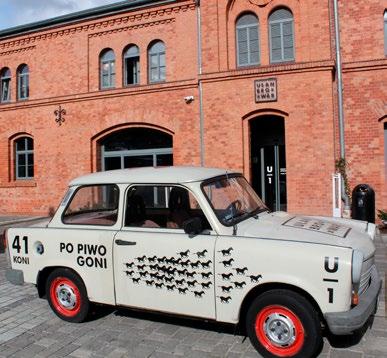
What was once 19th-century Prussian barracks, taken over by the Polish light cavalry (the Uhlans) after WWI, has been lovingly refurbished under the watchful eye of the local conservator-restorer, and is now a luxury complex with a five-star hotel, high-end apartments, and gourmet restaurants including Kyokai Sushi and Thai Thai (both on p.67). Definitely the place to eat in Łazarz.QA-10, ul. Wyspiańskiego 26 (Łazarz), tel. (+48) 61 662 44 42. Open 10:00-21:00; Sun 10:00-19:00.
One of those splendidly odd (and oddly instagrammable) concrete commie-era structures, the Hala Arena was actually inspired by the modernist Palazzetto dello Sport in Rome, which it resembles to a remarkable extent. Opened to the public in 1974, the sporting arena’s best days may be behind it, but its 4200 seats and 13 500 square metres of usable space are still regularly used for concerts and sporting events.QA-10, ul. Wyspiańskiego 33, tel. (+48) 61 866 60 31, www.arenapoznan.pl.
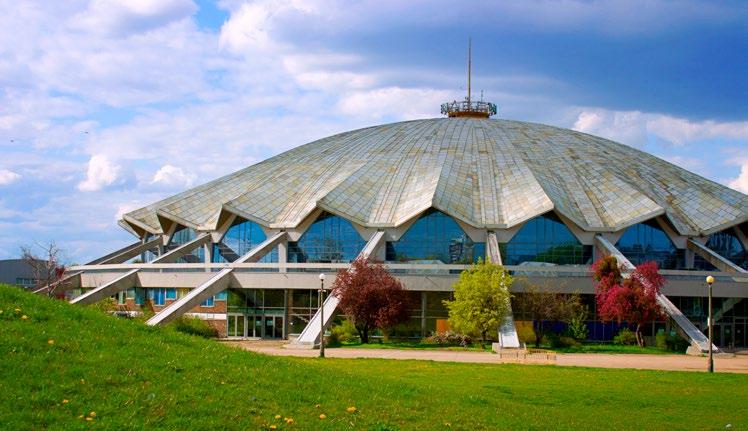

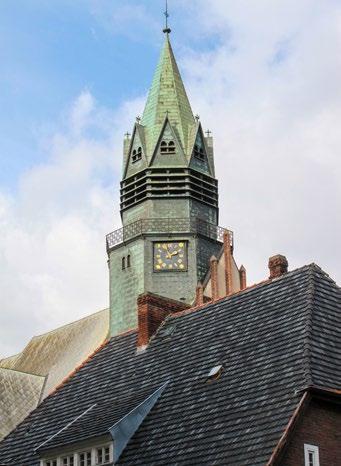
This neo-Gothic house of worship was a direct result of the rapid development of Łazarz during the late 19th and early 20th centruries. Completed in the years 1905-1907 for the local Protestants (at the time Poznań was still in Prussian-controlled territory, and thus had a sizeable Protestant population), St. Anna’s was converted to a Roman Catholic church in the final days of WWII.QA-10, ul. Matejki 43, www.swanna. tami.pl. Open 07:00-19:00; Sun 07:00-21:00.
While many foreign visitors to Central Europe may be unfamiliar with Poznań, businesspeople involved in foreign trade are likely to be more than aware of the city. That’s because Poznań is Poland’s trade fair capital with the title justified by the country’s largest fair grounds, where the biggest & best fairs in Poland take place each year.
Though Poznań’s rich trading tradition can be traced back to the thirteenth century, the true predecessor of today’s fair was the 1911 East German Industrial Exhibition, which showcased Germany’s achievements in annexed Polish territories. Six years later the Union of Merchant Associations, comprising merchants from Greater Poland and Eastern Pomerania, decided to develop a specialised cyclical expo based on the successful model of the Leipzig Trade Fair. This idea reached fruition on May 28, 1921, when the first Poznań Fair took place. Since then, the Fair’s fortunes have risen and fallen according to the political and economic changes that periodically moved through Poland and Europe: from playing a key role in re-integrating economic activities in the newly independent second Polish Republic, to the near-demise of the fair complex during WWII air raids (which destroyed the iconic Upper Silesian Tower), and to a new start in the post-war communist state.
Currently, the Poznań International Fair constitutes over 55% of the Polish exhibition industry, hosting some 10,000 exhibitors a year - approximately a quarter of them foreign - in the complex’s sixteen halls, which add up to 150,000 square meters of space. The total number of annual visitors attending the sixty or so trade fair events usually reaches half a million.
Though officially the heart of Łazarz, the district’s market square (Rynek) does not exemplify the majestic grandeur those words might typically evoke in Poland, but a recent renovation has put a bit more shine on it with new trees and benches. Laid out in 1894 under the name Lazarusplatz and surrounded by townhouses from the early 20th century, the market square in Łazarz is just that - a market. Until recently it was permanently occupied by around 300(!) somewhat shabby striped tents selling cheap local produce, fresh flowers, and assorted bric-a-brac. Now all that has moved under a strange flyingsaucer-like structure which cost the city some 40 million PLN. Regardless, you can buy almost anything you’d ever want here, and a lot more you’d never need.QC-11, Rynek Łazarski, www.targowiska.com.pl. Stalls are typically open 06:00-16:00; closed Sun.

Poznań is without a doubt a city overflowing with history; and it’s got a bit of a contemporary art and culture scene as well. We’ve created this chapter of the guide to help you discover the city’s best art and music spaces, find out about museums ranging from niche to national, and learn about sites related to some of the most important events in the Poznań’s thousand-year-old history.

Okay, so Poznań isn’t exactly in the Polish avant-garde when it comes to the art scene. While the bulk of the cultural goings-on are to be found in Kraków and Warsaw, here you’ll find some more traditional and low-key artistic endeavors, including solid operatic and philharmonic programmes and the occasional high-profile exhibition. Wandering around the streets will also reveal delightful and memorable street art, including the works of well-known Poznań artist Noriaki. We list our top recommendations below.
1 Grand Theatre
Built in 1910, the Grand Theatre is the most prestigious venue in town for opera and ballet performances - both classical and contemporary. QF-6, ul.Fredry 9, opera.poznan.pl.
2 Arsenał City Gallery
One of the oldest players on Poz’s art gallery scene, the Arsenal hosts free exhibitions by Polish and foreign artists.QJ-6, ul. Szyperska 2, arsenal.art.pl.
3 ZAMEK Culture Centre
One of Poland’s biggest cultural institutions, the Imperial Castle hosts over 2500 events anually, acting as a theatre, gallery, cinema, and concert venue. It also houses the 1956 Uprising Museum (p.41).QF-7, ul. Św. Marcin 80/82, ckzamek.pl.

For a long time, the height of Polish street art amounted to scrawling less print-friendly versions of “All Cops Are Bastards” and “Lech Poznań 4ever” on residential buildings and/or historical monuments in the dead of night. Better times for art have arrived though, and the local scene took off in 2011 with the first edition of the Outer Spaces Festival, which saw renowned muralists invited to spice up the drab exteriors of carefully-chosen buildings. Since then more murals have popped up, but not everyone has opted for the legal route: a certain Banksy-esque character operating under the pseudonym Noriaki is responsible for tagging the city walls with variations of Pan Peryskop (Mr. Periscope)
AKA The Watcher - a loveable maverick who has integrated himself into the fabric of the city. Now that you know, you’ll see him everywhere. Fancy a walking tour of Poznań’s best street art - like this mural at right by Grzegorz Myćki? Scan the QR code or head to iyp.me/74322f for a rundown of not-to-be-missed specimens, all pinned with GPS.
Tracing its origins back to 1919, the Poznań Philharmonic is the place to enjoy classical music in the city.QF-7, ul. Św. Marcin 81, filharmoniapoznanska.pl.
5
This important institution is filled with a rich history of modern Polish art, medieval art, and impressive Italian, Dutch, Spanish, and Flemish paintings.QSee p.41
Yes, this is shopping mall, but not only. This award-winning urban renewal complex (formerly a brewery site) is filled with sculptures and art installations and is absolutely is worth a look!QSee p.18.
For a relatively small city, Poznań has an impressive range of museums - though they also tend to be on the smaller side. Here we’ve listed the most important and interesting institutions, from state-of-the-art interactive museums to more traditional artefact collections. Scan the QR code to the right to head to our complete list of museums, which includes some very niche establishments.

Housed in the Royal Castle of Poznań, this museum has recently undergone huge changes which shifted the focus from medieval craftwork and princely decorations exclusively to applied arts, rolling out a 2000-piece exhibition of furniture, fabrics, ceramics, glassware, weaponry, and clothing from around the world. For those more interested in the actual history of the place, we recommend skipping the arts and checking out the (sparse) ground-floor exhibition dedicated to the castle and its founder, Duke (and later King) Przemysł II, as well as climbing the seasonally-open tower.QH-7, Góra Przemysła 1, tel. (+48) 61 856 80 75, www.mnp.art.pl/en/oddzialy/ muzeum-sztuk-uzytkowych. Open Tue, Wed, Thu 10:00-16:00; Fri 10:00-20:00; Sat, Sun 10:00-17:00; closed Mon. Exhibition tickets can be bought no later than 30 minutes before closing time. The park is open to the visitors throughout the week, during the following hours: 9:00-16:00. Admission 20/1-13zł. Tue free. U
Housed in the beautiful 16th-century Górka Palace, Poznań’s Archaeology Museum contains a collection of 42,000 rare and mystifying objects that chart life in North Africa and prehistoric Poland. The first part of the museum takes you through the earliest settlements in the region, with life-sized figures as well as miniature dioramas depicting life from the Stone Age to the Iron Age. The other permanent exhibits include ‘Death and Life in Ancient Egypt,’‘Archeology of Sudan,’‘Rock Art of North Africa,’ Tu powstała Polska (It was here that Poland was born) and Pradzieje Wielkopolski (The Prehistory of Greater Poland). Relating to the Ancient Egyptianthemed exhibitions, there is also a three-metre-tall granite monolith, the Obelisk of Ramesses II, located in the courtyard!QI-7, ul. Wodna 27 (Pałac Górków), tel. (+48) 61 852 82 51, www.nowa.muzarp.poznan.pl/en. Open 09.00-16:00; Fri 10:00-17:00; Sat 11:00-18:00; Sun 12:0016:00; closed Mon. Last admission to the museum is half an hour before closing. Admission 15/10zł. Sat free. Free audio guides avaliable in English. U
Located on Ostrów Tumski, adjacent to Poznań’s iconic Cathedral (p.26), the first floor of the Archdiocese Museum is devoted to temporary exhibits, while the next two floors are devoted to all manner of religious art and relics - paintings, statues, and robes preserved from Poznań’s line-up of bishops. QSee p.27
Joining the Croissant Museum is another sweet temptation under an educational guise: the Chocolate Museum where kids of all ages (including those quite grown and greying) can learn about cacao tree plantations, the history of chocolate, and chocolatemaking techniques while sampling decadent creations. The guided tours last an estimated 50 minutes and include workshops during which participants create their own chocolate bars - to take home, of course (if you can refrain from wolfing them down on the spot).
QH-7, ul. Wrocławska 12, tel. (+48) 502 45 41 77, www. muzeumczekolady.edu.pl. Open 10:00-18:00. Admission 50/45zł/person. U
Dedicated to the Poles who broke the German Enigma cipher during WWII, this modern, interactive museum offers puzzles and games, plus the history of Enigma and cryptology.QSee p.47
Located in Citadel Park, the remains of this Prussian fort prove to be the perfect location for the Museum of Armaments, which features various weaponry and ammo. Millitary buffs can utilise the same ticket to visit the Poznań Army Museum (p.54) so don’t forget!
QSee p.55
A large and excellent museum with a rich collection of modern Polish art (including interesting Impressionist works) in the new wing, and medieval art, impressive Italian, Dutch, and Flemish paintings in the connected old building. The museum also holds the largest collection of Spanish art (including Zurbaran and Ribera) in Poland and plenty of Polish art from the 16th century onwards. In addition, a Monet painting stolen in 2000 was recently recovered and is back on display. Paintings have extensive English explanations about the artist and topic. Visiting time: 2hrs.QH-7, Al. Marcinkowskiego 9, tel. (+48) 61 856 80 00, www.mnp.art.pl/en/oddzialy/muzeumnarodowe-w-poznaniu. Open 10:00-17:00; Fri 11:00-20:00; Sat, Sun 11:00-17:00; closed Mon. Tickets for the exhibitions can be purchased at least 30 minutes before closing.
Admission 20/1-13zł, Tue free. U
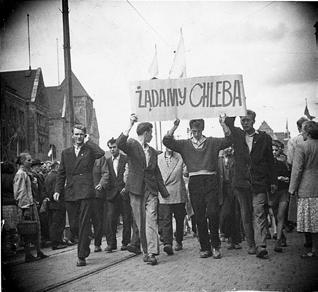
The Poznań Riots, or the ‘1956 Uprising’ (because PL loves its Uprisings), was the first recognised strike and street demonstration in communist Poland. Although brutally suppressed, this show of the people’s strength remains an intense source of pride for the local community, and though it would be another 33 years until the people of Poland would enjoy complete freedom from the Kremlin, the uprising led to a significant liberalisation of Soviet policy in Poland, and would act as a prelude to the 1980 Lenin Shipyard Strikes in Gdańsk that saw the birth of the Solidarity movement.
Within the basement of Poznań’s Zamek (p.23) this museum features a tank, stretchers used to carry the wounded, a display of arms and rifles, a room of Socialist propaganda posters, a typical Poznań family’s flat from the 1950s, and a direct copy of a detention cell. Most poignant of all, though, was the space set aside for 13 year old Roman Strzałkowski, the youngest to die in the troubles. Exhibits included his harmonica and domino set, and newspaper clippings showing Strzałkowski picking up prizes for his piano skills. QF-7, ul. Św. Marcin 80/82, tel. (+48) 61 852 94 64, www.wmn.poznan.pl. Open 10:0017:00; Sun 10:00-16:00; closed Mon. Admission 12/8zł. Tue free. U
These two huge crosses (21 and 19 metres) were unveiled on June 28th, 1981 - the uprising’s 25th anniversary. Nearby is an excellent multi-lingual electronic information point with some additional factoids to hear! QF‑7, Pl. Mickiewicza.
Symbolically connecting Poznań’s two oldest districts - Ostrów Tumski and Śródka - this modern complex presents the area’s history and its connections to the early Polish state.QSee p.25

Located in Citadel Park, this museum provides an overview of the city’s military history, with a particular focus on WWII and the inter-war period.
QSee p.54

Think that explaining cassette tapes to your kids is difficult? Try to get them to wrap their heads around this crazy 1920s entertainment system. Peer inside the Kaiserpanorama (called Fotoplastykon in Polish) for a collection of stereoscopic photographs of turn-of-the(twentieth-)century Poznań. In previous years this antique - which made it intact through WWII, and went through stints of basement confinement in the postwar years - resided in the Arsenał City Gallery on the main square before finding a new home inside the Arkadia building, originally a theatre, on Plac Wolności. Until July 31st 2022 you can also view a batch of photographs of Rome as part of a special exhibition.QG-7, ul. Ratajczaka 44, www.fb.com/fotoplastykonpoznanski. Open 10:0018:00; Sat 10:00-17:00; closed Sun. Admission 6/3zł.
Learn about the Bamber people, ethnic Germans from Bamberg who settled in Poznań in the 18th century, inside a mildly interesting museum that includes a 19th century timber house once owned by a wealthy Bamber farmer. Inside displays include old bonnets, looms, paintings, clothing, and timber furniture – everything you’d expect in an ethnographic museum - but very little written information. Q J - 8, ul. Mostowa 7/9, tel. (+48) 605 62 16 11, www.bambrzy. poznan.pl. Open Fri, Sat only 10:00-14:00.
Admission free. U
Dedicated to the delicious local delicacy of St. Martin’s Croissants, the Croissant MuseumQSee p.50
Part of Poland’s holy trinity of cabbage, potatoes and vodka - this fittingly underground museum is indeed devoted to the humble ziemnak or, as they are proudly known in the local dialect, pyry ! A bit self-aware of the absurdity of such a museum, the costumed staff take pains to be very earnest, but also keep things light-hearted, fun and highly interactive as they guide you through the exhibits, which recount the full history of this favoured tuber through the ages, and its importance to Poznań. You’ll discover all the different varieties of potato, the immense myriad of potatoey things that Poles can create in the kitchen, and every guest gets to season and bake their own pyra. Entertaining a lot of school groups, individual guests are welcome from Fri-Sun, and tickets should be booked online. Also, keep an eye out for the crowned mega spud on his vikingesque throne (see photo!) Q I - 6, ul. Wroniecka 18 (entrance from ul. Mokra), tel. (+48) 609 12 16 11, www.muzeumpyry.pl. Closed Mon. Admission 26/24zł, in English 28zł; the price includes guided tour and workshops.
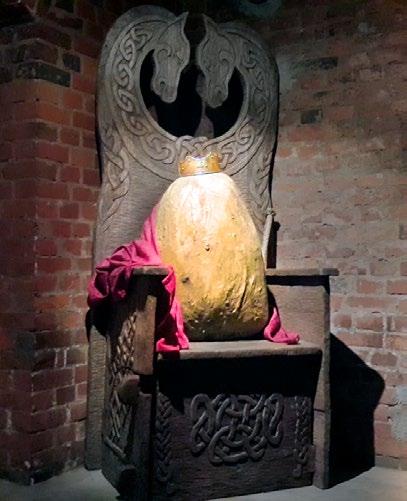
One of 18 forts built by the Prussians in the 1870s to protect Poznań’s perimeter, ‘Fort VII’ gained notoriety when it was used as a Gestapo penal camp between 1939 and 1944. The first Nazi concentration camp organised in occupied Poland, at least 18,000 Polish prisoners were processed here, of which 4,500 were murdered, though other estimates have the death toll as high as 20,000. The windswept grassy grounds make for a thought-provoking walk, along which visitors will see the ‘death wall’ - where up to seven prisoners were executed daily during Nazi rule, as well as dark underground tunnels used as makeshift gas chambers. Elsewhere a vaulted brick room holds a small but haunting display that includes a guillotine, an execution block, truncheons, whips, and arrest warrants. The personal effects of prisoners have also been preserved, including hand-written letters, playing cards, rosaries, and identity papers. Chillingly graffiti etched into the walls by prisoners can still be discerned, the writing framed with red and white ribbons. Reaching Fort VII is not an easy task, however. It’s found in the western suburbs, so your best bet is a taxi or Uber.QAl. Polska (Jeżyce), tel. (+48) 61 848 31 38, www.wmn.poznan.pl. Open 10:00-17:00; Sun 10:00-16:00; closed Mon. Admission 6/3zł. Tue free.


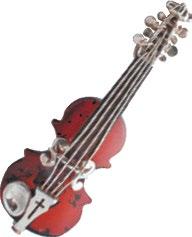



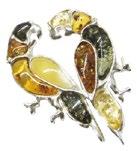

Amber and silver 925 with certificate Bernstein und Silber 925 mit Zertifikat Ambar y plata 925 (certificado) Ambra e argento 925 (certificato)
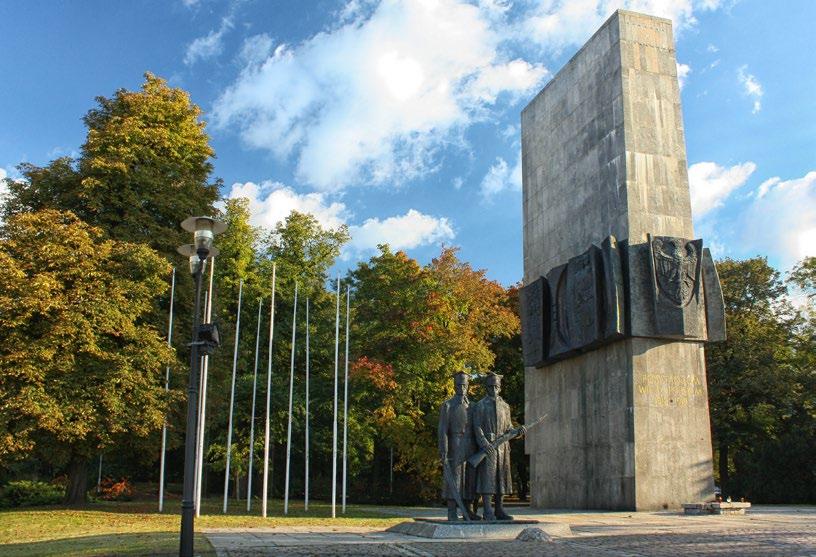
Since 1795 - when it was carved between Imperial Russia, Prussia and Habsburg Austria - Poland had been off the map and effectively ceased to be a country. Poznań enjoyed brief freedom when Napoleon’s conquering troops liberated much of Poland during their march east in 1806, however Napoleon’s military disaster on the plains of Russia resulted in the 1815 Congress of Vienna, which saw Poznań delivered back into Prussian hands where it would remain for over a century.
With Europe reeling after World War I, Germany in collapse, and Russia plunged into revolutionary chaos, Polish patriotic fervour once more simmered to the surface. The overwhelmingly Polish people of Poznań could sense independence was near, but there remained one crucial sticking point: German stubbornness to relinquish the Wielkopolska region. Woodrow Wilson’s plans for an independent Poland had failed to set any boundaries, and though Warsaw was back in the hands of a Polish government, Poznań was still answerable to Berlin. Ever since the Kaiser’s abdication on November 9, 1918, Poznań’s Poles had been plotting an uprising. Positions in local government and industry were forcibly seized by Poles and the countdown was on for outright war. Following weeks of tension the fuse was finally lit on December 27th. Historical accounts of how the Uprising started vary; some sources claim it was
the shooting of Franciszek Ratajczak and Antoni Andrzejewski on the steps of the police headquarters that started the initial fighting, though most point to a stirring speech given by the pianist and patriot Ignacy Jan Paderewski from the window of what was then the Bazar Hotel. While addressing the Polish crowd assembled below a German counterdemonstration passed by – within moments shots had been fired and the Uprising had begun. Historians disagree on which side started the hostilities, but either way there was no turning back the clock. Within hours Polish forces had captured the Poznań train station and post office, while other towns in the region joined them in rebellion.
Under the temporary charge of Stanisław Taczak, the Polish forces scored swift successes against a German army shattered from four years of world war, liberating neighbouring Kórnik and Mogilno, but counter attacks suggested a stiffening German resolve. Fighting continued and by January the situation was out of hand. To save the region from total anarchy, the government in waiting took charge of all civil and military issues, conscripting all Polish men born between 1897 and 1899 into military service. Taking their oaths of allegiance in what is today Plac Wolności (Freedom Square) (p.22), the Polish troops continued to march into increasingly fierce battles with their German counterparts.
Thankfully, peace was just around the corner, due in no small part to French intervention. February 14, 1919 saw the beginning of international peace talks, and within two days the French delegation had persuaded the Germans to sign an extension of the Allied-German armistice, this time including the Wielkopolska front. Sporadic fighting continued for the next few days, but to all intents and purposes, Poznań, and with it Wielkopolska, were liberated.
So what of the hotel at the centre of the Wielkopolska Uprising? Its history goes back to 1838, a time when Poznań was under Prussian occupation, and Polish institutions vied with their Prussian counterparts for the right to exist, especially on the dynamicallydeveloping Wilhelmsplatz (now Plac Wolności). It was in that year that social activist Karol Marcinkowski got a bunch of rich landowners together and started the Bazar Joint-Stock Company with the purpose of supporting pro-Polish social initiatives and businesses. Their main project was building a luxurious hotel and renting out space to Polish enterprises. The grand neoclassicist/neo-Baroque structure was built between 1839 and 1842, becoming the largest non-sacral building in the city. The plan worked marvellously: Bazar became home to the Landowner Bank, the Anthropological Society, a casino, three newspapers, and numerous other societies and businesses. In December of 1918 the Polish composer and politician Ignacy Jan Paderewski gave a rousing speech from one of the hotel windows, helping to spark the Wielkopolska Uprising. Throughout the Uprising the Bazar served as official HQ for the rebels. Nazi occupation marked an end to its glory days and it suffered horrendous damage during the 1945 siege. Renovations began immediately after liberation and the building became the property of the Orbis group in 1950 who operated a hotel from

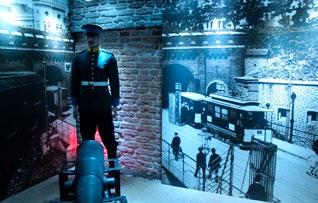
Primarily chronicling the 1918-1919 Wielkopolska Uprising (though the exhibition starts at the time of partition) this museum occupies a rebuilt structure that once served as home to the Royal Guard. A big renovation in the 2010’s took the exhibition from a series of artefacts to a modern multimedia creation on par with the Silesian Museum in Katowice or the Warsaw Uprising Museum in the nation’s capital (though much smaller, of course). Downstairs is a mish-mash of weapons, uniforms, reconstructed bunkers and trenches, and vintage photographs, which look great but fail to convey much meaningful information; the historical info is all upstairs, where you can also take a picture dressed as a Wielkopolska soldier. QH-7, Stary Rynek 3, tel. (+48) 61 853 19 93, www. wmn.poznan.pl/odwiedz-nas/muzeum-powstaniawielkopolskiego-1918-1919/. From March to October: Mon closed, Tue-Sat 10:00-17:00, Sun 10:0016:00; from November to February: Mon closed, TueSun 10:00-16:00. Admission 12/6zł. Tue free. U
there until 1990 when it was returned to its pre-war stockholders. Recently the building has enjoyed a remarkable renaissance, with its shopping arcades filled with designer stores and eateries.QH-7, Al. Marcinkowskiego 10, www.hotelbazar.pl.
Sitting in the northwest end of Drwęskich Park, the Wielkopolska Uprising Monument was designed by Alfred Wiśniewski and unveiled on September 19, 1965. The monument itself is a granite-covered 17 metre tall tower decorated with reliefs that depict the 1918-1919 Wielkopolska struggle, including the student strike in Września, famed Polish revolutionary Marcin Kasprzak, and the death of the first upriser Franciszek Ratajczak.QF-9, Corner of ul. Królowej Jadwigi and ul. Wierzbięcice.

The vital role played by Polish exiles during the Battle of Britain, who represented one in eight Allied pilots and whose 303 Squadron boasted the best hit rate against the Luftwaffe, is today fairly common knowledge in the UK. As is the role Polish forces played in breaking the siege of Monte Cassino, and the daring raid on Dieppe in 1942. A lesser known Polish contribution towards the Allied victory in 1945, but equally significant, is the battle that took place inside the minds of Poland’s finest academics to crack the German Enigma code
It all began in Poznań, namely in the mathematics class of the university. Ace students Jerzy Różycki , Marian Rejewski and Henryk Zygalski came to the attention of Polish intelligence services on account of their excellent German skills - Poznan used to be German, after all - and sharp mathematical minds. Recruited to attend cryptology courses in Warsaw alongside 17 other Poznań University alumni, the three were set to work in 1932 on cracking German ciphers. It was in the city’s Saxon Palace , which served as the seat of the Polish General Staff, they made the first vital Enigma breakthrough using a mathematical theorem since described as ‘ the theorem that won WWII .’
On the day before the Nazi invasion of Poland the three fled to Romania where they immediately sought contact with the Allies. Originally they turned up at the British Embassy in Bucharest, but having been told to ‘come back in a few days’ decided to try their luck with the French instead. This proved more successful and from there they found themselves in France, working in Cadix, a secret intelligence cell operating in the unoccupied south. With the risk of discovery by the Germans growing greater the team were forced to flee. Różycki drowned at sea in 1942 after the boat that carried him sank under suspicious circumstances; Zygalski and Rejewski however made it to Spain, in spite of being robbed by the man guiding them over the Pyrenees.
More calamity followed: the remaining pair were arrested by Spanish police and imprisoned, but freed the following year after intervention by the Red Cross. Seeking sanctuary in England they were employed in Boxmoor cracking simple SS codes. In spite of having done the groundwork that broke the original Enigma code their knowledge was not called on by the American and British codebreakers who were cracking new and improved Enigma codes at Bletchley Park, hence the vital Polish contribution has been allowed to fade in the memory.
After the war Rejewski returned to Poland where he spent the rest of his days under scrutiny from internal security services, and working in a succession of menial jobs. When he published his life story in 1973 he became an unwitting superstar, and his work was finally recognised with a series of honours. He died in 1980, buried in Warsaw’s Powązki Cemetery. Zygalski chose to remain in England and spent the post-war years working as a math teacher. He died in 1978 and is buried in London. Although the trio have since received numerous posthumous awards, their role in winning the war remains a little-known fact in the West, a cause not helped by silver screen rubbish like the 2001 movie Enigma
In recent years, recognition for the Polish codebreakers has come, even if sometimes it’s only a passing remark such as Alan Turing’s about an ‘old Polish code’ in The Imitation Game (2014). Since 1983 a memorial tablet at Poznań University’s Collegium Maius has been in place honouring the three lads, and in 2007 a monument placed in front of the Imperial Castle (p.23) followed suit. 2021 was the year when the city finally unveiled a state-of-the-art interactive museum dedicated to their achievement - the Enigma Cipher Centre, which we highly recommend visiting.
Designed by Grażyna Bielska–Kozakiewicz and Mariusz Kozakiewicz, this triangular prism with sequences of numbers commemorates the power trio of Różycki, Rejewski, and Zygalski. The monument was unveiled in 2007 and stands right in front of Poznań’s Imperial Castle, which was a university building in the pre-war years. Just next door is the sparkling new Enigma Cipher Centre. QF-7, ul. Św. Marcin 80/82 (main entrance to the Imperial Castle).
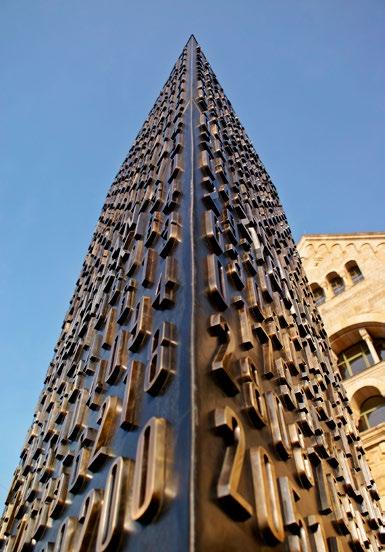
With such a significant claim to fame, it’s a surprise that it took Poznań until 2021 to open a museum dedicated to its three enigmatic cryptologists. It was worth the wait, though. This modern, interactive gem of a museum is a dive into the history of cryptology in general as well as the story of the Enigma specifically. Targeted more towards visitors with a keen interest in math and puzzles, the centre is filled with stations where they can try their hand at encoding and decoding messages using various ciphers, from slide rules to the hybrid Polybius Playfair cipher to one-time pads. If that’s not your cup of tea, no matter - the nicely prepared audioguide will lead you through the exhibits with minimal interruptions. Allow at least two hours if you want to listen through its entirety and check out some additional info on touchscreens. The exhibition finishes with a small section on the post-war IT revolution, which includes two Commodore 64 emulators with a selection of classic video games, which you can play to your heart’s content. Geeks unite! QF-7, ul. Święty Marcin 78, tel. (+48) 61 888 45 12, www.csenigma.pl/en. Open 09:00-18:00; Sat, Sun 10:00-19:00; closed Mon. Admission 20/15zł, family ticket 40zł. U

Poznań: the city of recreation? Could very well be. With the Warta River flowing right through it and numerous lakes, the city has plenty of activities to offer those who enjoy the water.
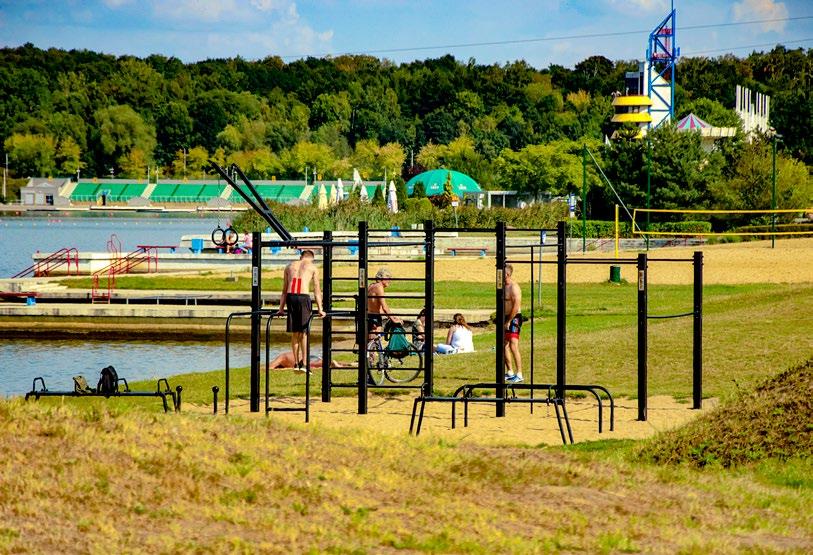
We’ve written extensively about some of those activities in this issue’s feature about the Warta River (p.8). But there’s more: two of the city’s most important urban recreation areas are the 89-hectare Citadel Park (p.54) - full of leafy promenades, historical monuments, and museums, and Lake Malta (p.52) - a man-made lake surrounded by attractions ranging from the New Zoo to skiing and skating in the winter to toboggan runs and mini golf in the warmer months. We cover both of these in this section of our guide. For more outdoor activities, consider Jeżyce’s Old Zoo and Botanical Garden (both p.30), and for a few rainy-day ideas check out the listings below.
Open from April till September, this lovely piece of real estate situated next to Lake Malta (p.52) offers 6 open-air bowling lanes.Qul. Krańcowa (Nowe Miasto), tel. (+48) 61 877 29 78, www.malta.poznan.pl. Open Fri 16:00-21:00 (Price 8 zł game/person or 50zł/hr per track; Sat, Sun 12:00-21:00 (Price 10 zł a game/person or 70zł/hr per track); Closed Mon-Thurs.
Big news for all amateur aviation enthusiasts: Poland’s first full flight simulator for the general public is here! This fully functional 737NG airliner simulator has been painstakingly modelled on the real thing, with not a single button out of place, and it can all be in your hands for 15, 30, 60, 90, or 120 minutes. And if you’re looking for something to really jazz up a boring business meeting, an important birthday, or your n-th wedding anniversary, this might just be your no. 1 bet!QH-9, ul. Kwiatowa 2, tel. (+48) 518 39 54 84, www.gearup.aero. Open 13:30-21:00; Sat 10:3021:00; Sun 10:30-20:00; closed Mon, Tue.
Experience the marvels of Poznań and the surrounding region of Greater Poland (Wielkopolska) with JustPoznan, a trusted guide service operating from the regional capital. Whether travelers prefer Polish, English, German, Italian, Russian, French, or Spanish, a team of knowledgeable guides are ready to accompany them on a remarkable journey. The millennia-old city of Poznań has a wealth of history
and remarkable tales to share, however, nearby centres like Kórnik, Puszczykowo, Rogalin, and many others on the ancient ‘Piast Route’ are waiting to be discovered by those willing to take the extra step. If you’re interested, get in touch with JustPoznan to discuss personalised travel plans and crafting a flawless itinery that is tailored to their specific interests. Drawing from their extensive practical experience, JustPoznan’s guides adeptly breathe life into these destinations, illustrating the history of Poland’s oldest region in a way that few can! These guids also offer comprehensive support during your entire stay, including arranging accommodations, meals, tickets, and transportation. Let JustPoznan enhance your adventure through Poznań and the hallowed lands of Greater Poland!Qtel. +48 609 605 115, www.justpoznan.pl

Anyone looking to escape the raucous buzz of Poz’s city centre could do a lot worse than relaxing with a fine massage. A peaceful, modern environment with English-speaking service desk, only five minutes from the market square, Thai Smile Massage is an ideal place to forget about the day’s woes while you let one of the authentic Thai massage therapists work their wonders. Two rooms to choose from and a range of massage types including herbal compress massage, foot massage, and sports massage is enough for the IYP staff to give this place the thumbs up.QG-8, ul. Ogrodowa 17/4, tel. (+48) 727 90 52 96, www.thai-smile.pl. Open 12:00-22:00.
The 116 hectare New Zoo was opened to the public in 1974 after seven years of construction. Housing over 2,000 beasts representing nearly 350 species, it’s comprised of 60 percent pine and mixed forests with a man-made stream and string of ponds running through the grounds. In this way many of the creatures live in recreations of their natural habitats rather than concrete pens. Highlights include the modern elephant house, and circling the whole shebang is a seasonal mini-railway, meaning visitors can jump off at whatever creature cage takes their fancy. As the zoo is located beyond the far east end of Lake Malta (not actually on the lake), during the warm season (April-September) you can get there by taking the Maltanka minirailway (p.53) to the last stop, ‘Zwierzyniec’. If coming from the centre of Poz, take tram 4, 8, or 17 from ‘Plac Wielkopolski’ to ‘Rondo Śródka’, then change to bus 184, getting off at ‘Nowe ZOO’. Alternatively, a taxi from the centre costs about 30zł.Qul. Krańcowa 81 (Nowe Miasto), tel. (+48) 61 877 35 17, www.zoo.poznan.pl. Open 09:0019:00. Admission 30-45zł. U
While Lake Malta is favoured by families and sporty types, the slightly smaller Rusałka has long been favoured by hikers, cyclists, and nature lovers. Here, 3,300m of wooded coastline is woven with intimate walking paths, ancient trees, misty streams, and several forgotten war memorials. On that note, the Wielkopolska Martyrs Museum (p.43) is within walking distance of the south shore. In summertime, the northern coast becomes Poznań’s most popular swimming and sun-bathing spot, with water sports equipment rental and a children’s playground available. Wander to nearby points of interest include Sołacz and the Botanical Garden (both on p.30).



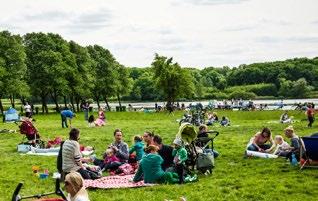
Welcome to Invisible Street, the extraordinary destination in Poland that unveils a realm that the majority of the world has never experienced. Picture a place where darkness shrouds everything, forcing you to navigate solely by means other than your sight, and yet, despite your lack of vision, you’ll discover how to adapt, interact, and live your daily life with astounding normality. Invisible Street stands apart from other attractions by captivating visitors with its unmatched uniqueness. With only three such venues in Poland, including this one in Poznań, this is where you can experience the unseen, feel the intangible, and comprehend the invisible.QB - 10, ul. Matejki 53, www.niewidzialnaulica.pl. Open 12:00-18:00; Sun 12:00-17:00. Normal: Mon - Thu. 32 PLN, Fri. - Sun. 34 PLN Discount, student: Mon. - Thu. 27 zł Fri. - Sun. 29 zł.
Yes, there are the billy goats and the international expos, but St. Martin’s croissants (rogale świętomarcińskie) might be Poznań’s best-loved trademark. Baked specifically for St. Martin’s Day (November 11th), these goodies stuffed with white poppy seeds enjoy fame all around Poland. In our sweet-tooth’d opinion, seeking out and indulging in a few St. Martin’s croissants is an essential activity in its own right! Furthermore, there is actually a surprising that an entire museum dedicated to them has is a fairly recent addition to the plethora of city cultural institutions! The Croissant Museum in Poznań’ hosts numerous daily and weekly shows - the English show takes place at 14:00 on the weekends and irregularly during the week
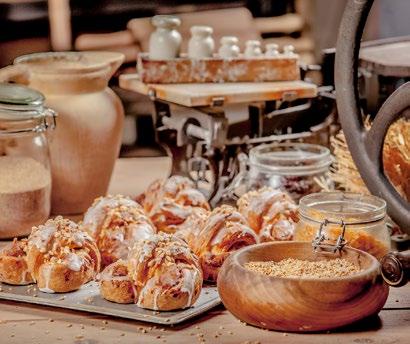
(check the website for an up-to-date schedule).


The 50-minute session includes a multimedia presentation, legends, a tour of the historic museum building, a chance to bake croissants using traditional tools! That being said, it takes ages for your hard work to bake, so you may be better off subtituting them for one at the gift shop!QI-7, Stary Rynek 41/2 (entrance from ul. Klasztorna 23), tel. (+48) 690 07 78 00, www.rogalowemuzeum.pl. Shows starting times: 11:00, 12:30, 14:00, 15:30, 17:00. Admission 31/28zł.
The largest trampolining entertainment centre in Poznań, Stacja Grawitacja is a sprawling 5,000 square meters of adventure and excitement for all ages. Found inside Galeria Pestka, here you can choose from a wide variety of attractions. Visitors can enjoy bouncing around in the trampoline park, navigating through the huge cushions and acrobatic tracks, and tackling the year-round Rope Park. There’s even a NINJA obstacle course and volleyball and basketball courts with trampolines for those who want to test their physical prowess. Stacja Grawitacja is also home to the only trampoline obstacle course in Poland, making it a unique experience for visitors. It doesn’t just stop there - There are sports trampolines, climbing walls, and acrobatic and gymnastic sports zone, as well as interactive games combined with trampoline activity, successfully gamefying the already-exciting physical activity! Furthermore, the climbing wall also includes an interactive and high-tech twist to the dizzying experience. For those who prefer more leisurely pursuits, Stacja Grawitacja offers classes for children, teenagers, and adults, as well as classes on sashes. Visitors can also enjoy the Parkour and FreeRun Zone, or simply relax in the huge mezzanine with a pleasant little café while waiting for their turn to play. Last but not least, this entertainment centre features the only Bubble Football pitch in Poland, making it a must-visit destination for sports enthusiasts and anyone who loves a good time.
Events of all kinds are welcome at Stacja Grawitacja, whether you’re organising something corporate, a birthday, a PE class trip, or anything else. The space and facilities are here to accommodate you - All you have to do is inquire!QAl. Solidarności 47, tel. (+48) 607 13 66 66, www.stacjagrawitacja.pl/poznan. Open 10:00-21:00; Sun 10:00-20:00. (1h-40zł, 2h-55zł, all day- 80zł).
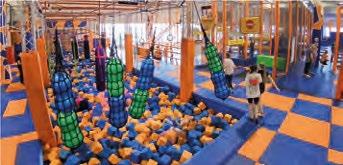

Of
many lakes it’s Malta to the east that is the best known, and its surroundings are well worth further investigation. Surrounded by parks and woodland, today it’s one of the key recreation areas in the Greater Poland region!

Formed in 1952 as a result of damming the Cybina, this 2.2km long lake is the largest man-made lake in the city, with an average depth of 3.1 metres. In both summer and winter, it’s a hit! With an ice-rink, ski slope (the first in former communist Europe), a world-class regatta course, zoo, water park, and many other attractions, including several historical sights. Just east of the centre, but miles from the madness of the market square, if you’re in town to decompress, head to Malta. Just outside of Poznań, this is a must-do for summertime outdoor activities!
A double ski-slope in winter, Malta Ski changes hats in summer to offer even more fun. Attractions include an 18 hole mini golf course overlooking Lake Malta (Ages 6+, 25/18zł), a free-entry playground with slides, mazes, and obstacles, a summer toboggan run (Ages 3+, 10-25zł) and the Adrenaline Alpine Rollercoaster, a 500 metre long track with wild twists and loops (Ages 3+, 15-40zł).Qul. Wiankowa 2, tel. (+48) 501 35 51 53, www.maltaski.pl. Open 11:00-20:00.
Located on the north shore of Lake Malta this yearround facility offers sport pools (one Olympic-sized and another with a 10-metre diving tower), a water park (a series of 16 pools including a wave pool and children’s play pool), and 13 water slides along with two wild rivers. There is also the World of Saunas (14 saunas, two of which are outdoors, and a vapour bath) and, most recently, a full spa complex (Spa 1306) with underground thermal springs, offering therapeutic and beauty baths including Turkish Hammam and Rasul mud bath, massage, hydromassage, rehabilitation, Pollogen slimming and rejuvenating treatments, and more from the fully trained staff.QP-8, ul. Termalna 1, tel. (+48) 61 222 61 61, www.termymaltanskie.com.pl. Open 06:00-23:00; Sun 07:00-23:00; SPA open 11:0021:00; Sat, Sun 10:00-21:00.
Pleasing the paying public since 1956, this is one of the last 600mm narrow gauge railways in PL, faithfully pulled by ‘Borsuk’ (Badger) - a steam engine with two whistles. Operating from late April to late September, it’s a unique attraction for rail buffs, and also a great way to view Malta. Better still, this is one of the most practical ways to get to the ‘New Zoo’ (p.49)– catch it from the Maltanka stop near Rondo Śródka (M-6) and ride it to the end, namely the Zwierzyniec stop at the zoo. Trains run on the hour Mon-Fri and on the half hour Sat-Sun, with the first ride at 10:00 and the last one at 18:30; tickets 10/7zł.QM-7, tel. (+48) 61 839 66 90, www. mpk.poznan.pl/turystyka/maltanka. Open 10:00-19:00. (11/8 zł).
Open April-October. Located on the east end of Lake Malta, this adventure park features 4 ropes courses (3 large ones and one smaller one for kids over 3 years old) and two Tyrolkas - sweet 70m zip lines. If you need a rest afterwards, there are two designated picnic areas with bonfire and BBQ options. Unfortunately, it’s not possible to access Pyrland Park by car. Instead, take bus 157, 184 or 181. Costs of tickets depend on the route, but are usually 33/39zł during the week, 35/45zł on weekends.Qul. Abpa A. Baraniaka/Chartowo, tel. (+48) 660 04 89 01, www. pyrlandpark.pl. Monday - Friday 13:00 - 18:00 Weekends and Holidays 10:00 am - 6:00 pm. Rope courses 25-39zł each, or 40-99zł for combination; kids 20zł; family ticket (2 adults plus 1 kid) 85-95zł. Tyrolka 23zł (10zł with ropes course ticket).

Lake Malta is situated just to the east of the city centre, and Rondo Śródka - at the lake’s northwest corner, is the best place to access it. Below are the public transport options from two main points in the centre. Alternatively, a taxi from the centre to the north shore will cost about 30-35zł.
From the main train station (D-9), take tram number 6 from the ‘Poznań Główny’ stop (walk just past the Avenida shopping centre going east) directly to ‘Baraniaka’. The journey takes about 14 minutes.
From the Old Town Square, take tram number 4, 8, or 17 from either ‘Pl. Wielkopolski’ (H-6) or ‘Małe Garbary’ (I-6) to ‘Rondo Śródka’.
From ‘Rondo Środka’, take buses 157 and 184 to stop Chartowo or Kopiec wolności.
Just north of Poznań’s Old Town sits Winiary Hill and 89 hectares of picture-perfect green space known as Citadel Park. Much like any coveted location in Poland, this scenic overlook has a long history that involves multiple name changes, military battles and even some old-fashioned mystery. For visitors, the park offers not only beautiful promenades and leafy city escapes, but also a plethora of monuments, museums and historical tales
Re-opened after a long renovation, the museum provides visitors with the chance to learn more about the city’s military history, with a particular focus on WWII and the inter-war period. A large number of items from these times are on display, including various newspaper cuttings, weapons, photos, and uniforms. But other eras are covered too, with some artefactssuch as old bullets and army storage devices - dating back as far as 1897. Note that the ticket also includes entrance to the Museum of Armaments, also located in Citadel Park.QI-4, Al. Armii Poznań (Po. Armii Poznań Citadel), tel. (+48) 663 86 64 14, www.wmn.poznan.pl. Open 10:00-17:00; Sun 10:00-16:00; closed Mon. from March to October: Mon closed, Tue-Sat 10:00-17:00, Sun 10:00-16:00; from November to February: Mon closed, Tue-Sun 10:00-16:00. Admission 10/6zł, Tue free; ticket also valid for the nearby Museum of Armaments. U
Citadel Park hosts several cemeteries, but the one typically of most interest to tourists is British Military Cemetery (also known as the Commonwealth Cemetery). Why? It’s here that you’ll find the graves of several of the men involved in what is now known as “the Great Escape” (it wasn’t just a movie, folks!). In addition, the cemetery houses graves of servicemen from WWI (all of whom died in various parts of Poland as POWs), and those who died in bombing operations over what is now the Polish city of Szczecin.QH-4, Park Cytadela. Open from dawn till dusk.
One of the most noticeable features of Citadel Park is the Soviet Obelisk located prominently at the top of the grand staircase as you enter the park from Aleja Armii Poznań (H-4). The giant Socialist Realism column
If the weather is nice there’s no reason not to walk to Citadel Park from the Rynek. The stroll is just under 2km and should take 25-30 minutes. Those who prefer a quicker route can grab bus numbers 174, 176, 190, or 603 from ‘Wielka’ to ‘Garbary’
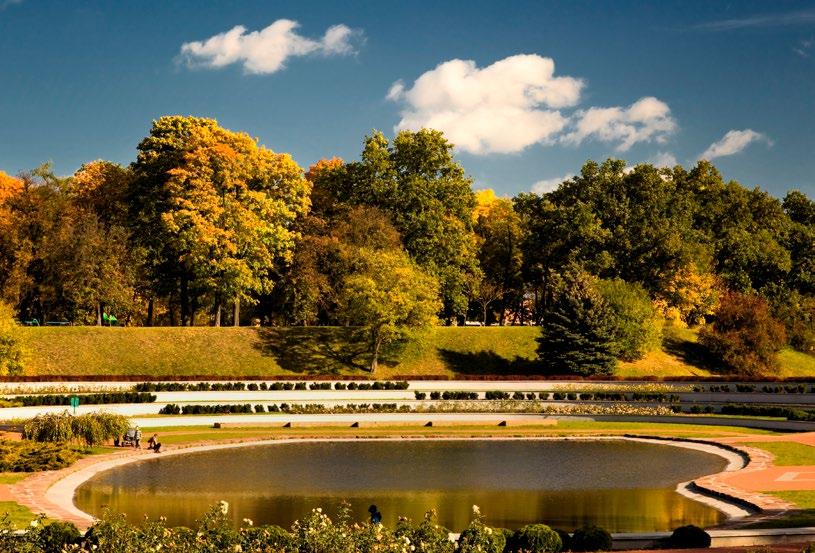
is dedicated to the Russian soldiers killed during the 1945 siege of the fort, and it’s most interesting aspect is perhaps the one you can no longer see: the large red star affixed to the top which disappeared in the dead of night after the fall of communism in Poland in 1989. Official complaints by the Russian Embassy to track down the star and its thieves were, unsurprisingly, largely ignored by police, and for years the public was left to speculate what became of the red emblem (a rumour that the star was filled with jewels proved to be one popular urban myth). In recent years, however, a local journalist looking into the mystery was able to swiftly solve it: local firemen had removed the star using their rescue ladders. They fessed up and turned it over without consequence to the city, which has plans to restore it and eventually put it on display at the Historical Museum of Poznań.
QH-4, Park Cytadela.
The remains of this Prussian fort (which was used as a war laboratory to produce gunpowder and shells during World War II) proved to be the perfect location for the Museum of Armaments, which features displays of various (mostly Nazi and Soviet) weaponry and ammunition, a dynamic diorama showing anti-tank gun positions, and photos of battles from Poznań’s history. Most interesting for military buffs, however, is the outdoor exhibition laden with a whole host of war machinery including a T-34 tank, a ‘Katyusha’ rocket launcher, bombers, and a MIG-15.
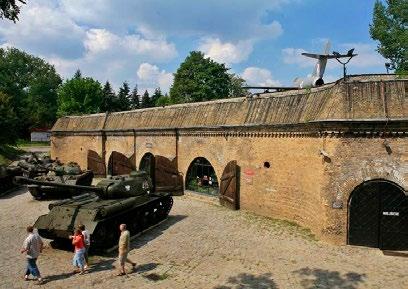
QH-3, Park Cytadela, tel. (+48) 61 820 45 03, www. wmn.poznan.pl/odwiedz-nas/muzeum-uzbrojenia/.
Open 10:00-17:00; Sun 10:00-16:00; closed Mon. from March to October: Mon closed, Tue-Sat 10:00-17:00, Sun 10:00-16:00; from November to February: Mon closed, Tue-Sun 10:00-16:00. Admission 12/8zł, Tue free; ticket also valid for the nearby Poznań Army Museum.
 Abakanowicz
Abakanowicz
Unveiled as part of Poznań’s 750th birthday celebrations in 2002, this massive troop of towering, headless cast iron figures marching aimlessly across Citadel Park is officially titled “The Unrecognised” (“Nierozpoznani”). 112 in all, each measuring 2 metres tall, the odd installation is the work of local arts grad and international art star Magdalena Abakanowicz, who is keeping mum on its meaning. Those with ties to Chicago might recognise a similar installation in Grant Park, while a few more of Abakanowicz’s headless fright patrol can be found wandering lost in the courtyard of the Imperial Castle.QI-3, Park Cytadela.
Certainly one of the nicest and most popular parts of Citadel Park, particularly in fine weather, is the ‘rosarium.’ Consisting of six landscaped terraces planted with different roses, trees, and shrubs descending to a small lake at its centre, this is perhaps Poz’s most romantic corner, as evidenced by all the couples getting very cosy on the numerous benches scattered about. Go for a stroll, stop to smell the roses, and maybe sneak in a snog on the side. QH-2, Park Cytadela.
Erected in 1986, the ‘Bell of Peace and Friendship
Among Nations’ was installed too late to spare Poznań from a largely turbulent 20th century, but it plays a role in the remembering when it’s rung on holidays and anniversaries such as Liberation Day (February 23rd) when the Germans capitulated at the fort during World War II. Weighing 850 kg, the dove-embossed bell hangs 10m above the ground and can allegedly be heard from 10km away.QI-4, Park Cytadela.
Gastronomy has grown considerably in Poznań, and the city is home to a large number of hipster and world-class restaurants serving a wide range of cuisines. At right we highlight some must-try regional dishes, while over the following pages you’ll find Poznań’s most noteworthy dining establishments, divided into basic categories with the type of cuisine listed under the venue name; for more options visit our website. In terms of tipping, 10% is standard (easy math). Smacznego!

Nearly ubiquitous as a starter in Poznań’s Polish restaurants, gzik is made of quark cheese mixed with cream and chives or radish. Served together with jacket potatoes, this 19th century peasant dish is known as ‘pyra z gzikiem’ in local parlance and recognizable across Poland as a Wielkopolska creation. It’s vegetarian-friendly, too, which isn’t often the case with traditional cuisine.


Whereas in most corners of Poland, until fairly recently, Peking duck was an eyebrow-raising oddity, and ‘edible’ poultry was limited to chicken and turkey, Wielkopolska has long liked its kaczka. Traditionally served roasted with cabbage, apples, and dumplings, duck has recently also founds its way into pierogi and even burgers. You’ll find that this is the star of the menu in many Polish restaurants in the city.

Grey - the #1 least appetising colour. Unfortunately, that’s just the hue raw potatoes turn after you shred them, a necessary step in the making of this regional dish. After shredding, the potatoes are mixed with egg and flour and cooked to lumpy perfection. Traditionally accompanied by sauerkraut, szare kluchy aren’t exactly fashionable anymore, though they seem to be making a bit of a comeback.
Traditionally prepared for St. Martin’s Day (November 11th), a big deal in Poz thanks to a church named after the saint, these sweet treats have become a local trademark. Filled with a poppy seed and almond paste and topped with a healthy pile of sugary glaze, the pastries date back to at least 1860. They’re ubiquitous in November, but can be found in some bakeries year-round.

Though much of their cuisine is shared with Poland as a whole, Poznań and the wider Wielkopolska region do have some of the most distinctive dishes in the country. Here are a few pickssmacznego!
A perfect breakfast option and a welcome opportunity to get yourself over to the art-filled Stary Browar (p.18). At this French bakery, the most important meal of the day is served all day everyday. Choose from classics like croque madame, crepes, croissants, tartines and more - all made from authentic French ingredients, and delicious fresh bread that is baked on-site. You’ll find a second location in the Sołacz district (p.30), Aleja Wielkopolska 40a.QG-9, ul. Półwiejska 32 (Stary Browar), tel. (+48) 61 667 15 55, www.petitparis.com.pl. Open 09:00-21:00; closed Sun. €. U6
One of our favourite breakfast spots, some time ago ALEkosmos moved to a new, larger locale, making room not just for a lush tangle of houseplants (some planted in a bathtub), but also for an upsized menu. On our last visit, we were knocked off our feet by

the avocado toast with red pesto, cherry tomatoes, eggs, and greens, but there are many other enticing dishes to try as well, from Italian foccacia with ricotta cheese and Parma ham to challah bread French toast with blueberry jam, vanilla cream, salty caramel with peanut butter and roasted almonds! Breakfast is served until 14:00; after that, you can pop in for coffee and cake.QB - 6, ul. Jackowskiego 43, tel. 797 817 621. Open 09:00-19:00; Sun 10:00-19:00. €. B6
Obnoxious in principle, but perfectly warm and inviting in actuality, Stragan adheres to some stringent self-imposed rules, including a nonnegotiable no-Americano policy (they also refuse to make scrambled eggs). Instead, they’re committed to serving top-notch alternatively-brewed coffee, using all the new-fangled (or just currently trendy) methods like drip-brewing, aeropress, Chemex, and siphon; boxes of equipment are displayed on the
back wall and available for sale, as are coffee beans. The dedication shows - their coffee was among the best we’ve tasted, so give it a go if you’re a caffeine enthusiast. Light breakfast is served as well.QG-7, ul. Franciszka Ratajczaka 31, tel. (+48) 789 23 39 65, www. craftcoffee.pl. Open 08:00-21:00. TB6
Specialty coffee, several varieties of homemade cheesecake, and (mercifully optional) language lessons are the order of the day at this cosy and modern Jeżyce cafe. The attention to detail here is praiseworthy: coffee comes served with a laminated bit of paper describing the bean variety, origin, and flavour profile, so some learning is unavoidable after all. Those keen on improving their English or Spanish can set up lessons with a private tutor, which take place in a separate section of the cafe (85zł/h, with a beverage included in the price). A rotation of tasty breakfast dishes is served before 14:00 on weekdays and all day on weekends.QC-7, ul. Zwierzyniecka 41, tel. (+48) 573 93 89 89, www.mowishmash.pl. Open 09:00-18:00; closed Mon. B6
Should you wander out to the largely residential Łazarz district - known for its Palm House (p.35), swanky City Park complex, old-school open air market, and mild state of disrepair - definitely aim for a pit stop at this charming cafe just off the district’s main square. Called ‘donut and coffee’, the selection of treats won’t surprise you, but the quality will - the delicious pączki (Polish hole-less doughnuts) are homemade, often warm, and come in a variety of fillings, and the specialty coffee is brewed using a number of alternative methods.
Recommended.QC-11, Ul. Rynek Łazarski 8, tel. (+48) 513 41 01 14. Open 10:00-19:00; Sat 10:00-18:00; Sun 11:00-18:00. TB6




Absolutely smashing breakfast and specialty coffee (cold brew, chemex, aeropress, the works) in a typical ‘cool 2010s interior’ of exposed brick, light wood, plants, and wall art - pleasant. The menu changes regularly, but expect elevated versions of popular brekkie dishes like waffles (served, for example, with ricotta and rhubarb), shakshouka (with roasted eggplant and feta cheese), and avocado toast, with a strong focus on local ingredients, from artisanal sausages to freshly baked sourdough bread. You can even grab yourself a bag of coffee beans from their own bounces coffee roaster. Check it out!QC-6, ul. Bolesława Prusa 4/2, tel. (+48) 501 03 17 87, www. unoespresso.pl/kawiarnia. Open 08:00-15:00; Sat 09:0015:00; closed Sun. €€. 6
Already in Warsaw and Kraków, the gastronomic world’s highly-regarded MICHELIN Guide has recently expanded its listings to include Poznań! Maintaining its independent approach, the guide’s expert inspectors will apply the rigorous criteria of quality produce, cooking mastery, flavour harmony, chef’s personality, and consistency. Here are the restaurants to look out for!
Nearly a century ago in France, brothers, André and Edouard Michelin created this system of gastronomic appraisal as a way to improve their guide for motorists. Garnering a Michelin star remains one of the most prestigious honours in the world of gastronomy, and such an award also gets you place in their iconic red print guide - AKA “the foodie bible” - not to mention worldwide recognition! A restaurant can earn a maximum of three stars - one means that the restaurant is particularly worth a visit in its category; two that it has outstanding food and is worth going out of your way to visit; and three testifies to the absolute uniqueness of the cuisine! In addition to stars, you can earn other Michelin accolades awarded for decor, service and overall ambience of the establishment and for great value for money (Bib Gourmand). And so, the cullinary magic of Poznań recently drew the attention of Michelin inspectors, who have since visited the local gastro scene anonymously to give their appraisal of numerous restaurants. Now the results are in and we are happy to share the results with you!
In 2023, a Michelin star has been awarded to one Poznań restaurant...

Restauracja MUGA
utensils International
MUGA is known for its perfect mixture of fine European food, great service, and excellent wine. The seasonal menu rivals anything else we’ve sampled and the bright, well-lit interior makes for a warm and inviting stay. A perfect spot for courting couples, business deals, and those looking to impress; firstdaters should head to the far corner where intimacy is almost encouraged. On it’s assessment of MUGA, the Michelin Guide comments that “Dishes such as scallops with sea lettuce and quinoa and roast duck are characterized by depth, elegance, finesse and balance in the cuisine.” Take advantage of their Summer garden, which is open until September!QH-8, ul. Krysiewicza 5, tel. (+48) 61 855 10 35, www.restauracjamuga.pl. Open 17:00-22:00; Sat 15:00-22:00; closed Mon, Sun. €€€. B
utensils International
Poland’s first-ever restaurant & cheese bar in Poland, created by those with a passion for unique flavours. Fromażeria features a seasonal à la carte menu, with the spring edition featuring elegantlyprepared pastas, salmon bass from the pan, and beef cheek with a Jerusalem artichoke gratin and Bleu d’Auvergne A.O.P. cheese! Along with a tasting menu and a very extensive wine list, smaller bites can be enjoyed at the cheese bar, with boards of international slices complemented with the option of a discounted carafe of wine!Qul. Ratajczaka 27, tel. (+48) 61 200 11 96, www.fromazeria.pl. Open 15:0022:00; Fri, Sat 14:00-24:00; Sun 14:00-22:00; closed Mon.

utensils International
Featuring Head Chef Filip Cwojdzinski, whose award-winning credentials include Michelin-star’d restaurants in the UK and Ireland, TU’s imaginative international menu, wine list and stylish premesis have us won over time and time again. A good chunk of the menu here is surf n’ turf, which lends itself fantastically to their woodfire outdoor grill (Friday to Sunday) where you can experience live cooking in their lovely garden space. You can, of course, enjoy their modern-rustic indoors, incredibly designed by the multi-talented architect and co-owner, Karol Fiedor. In such a setting, you may opt for one of their expertly-crafted Italian dishes or venture elsewhere on the continent.Qul. Grunwaldzka 34a, tel. (+48) 887 22 21 21, www.turestaurant.pl. Open 13:00-22:00; Fri, Sat 13:00-23:00; Sun 13:00-19:00; closed Mon.
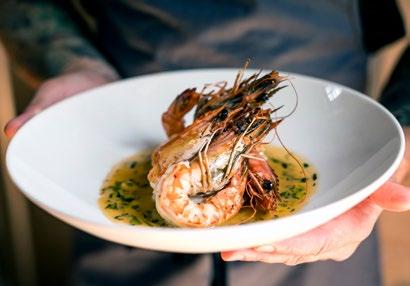
The Bib Gourmand distinction has been earned by...TU.RESTAURANT
Located in the heart of Poznań’s Zawady district, 62 Bar & Restaurant is one of is place where culinary dishes are truly realised through the passion of its creators. Chef Jarek Kin and his crew have created imaginative culinary masterpieces that truly enchant the senses, and, on that note, we recommend turning your discerning taste buds, nostrils and eyes to their incredible tasting menu to find out why Michelin had something to say about this place - Milk veal, tart with wild rice jam, nori cream, and even St. Martin’s Croissant (p.57) are just some of delicate creations to indulge here, while elsewhere, regional serves of szagówki (potato dumplings) with regional cheese sauce and cauliflower, and smoked trout from Zielenica (Pomerania) with root vegatables, and caviar, are a spiritual journey the land and waters that yield such wonders. Their cosy modern dining space that resides on the 3rd floor of the district’s Harley Davidson Building also offers lovely terrace views of the surrounding area. Clearly, a trip out here from the city centre is worth it!Qul. Sw. Michala 62 (Harley Davidson Building), tel. (+48) 57 133 05 56, www.michala62.pl. Open 15:00-21:30; Fri 15:00-22:30; Sat 14:00-22:30; Sun 12:00-19:00; closed Mon.
Sometimes a restaurant is worth going out of the way for and this spot certainly falls into that category. Located quite a bit away from the hustle and bustle of the city centre (in the suburb of Wilda, cab fare 30zł),
A Noż Widelec offers a small but tempting menu of soups, fish, and meat dishes all presented in a bright and modern surrounding and served up by a team of friendly staff.Qul. Czechosłowacka 133 (Świerczewo), tel. (+48) 506 83 12 65, www.anozwidelec.com. Open 12:00-21:00; Sun 12:00-17:00; closed Mon. (30-120zł) €€€.
International
Poznań fine dining doesn’t get better than this. Winner of countless accolades, Delicja serves a combo of Mediterranean and Polish recipes including superb Rump of Venison. This definitely falls at the upper end of the food chain, and the interior comes filled with silver candleholders, immaculate linen, and live music - check online for the concert schedule.QG-7, Pl. Wolności 5, tel. (+48) 61 852 11 28, www.delicja.eu. Open 16:00-22:00; Sat 16:00-23:00; closed Mon, Sun. E6W
Nooks
utensils Mediterranean
Ideal for every and any occasion, Nooks’ colourful interior sees quality meat & fresh seafood served with a tasty and modern flair, taking in many influences from all over the world and challenging the idea of your typical surf n’ turf restaurant in Poland. Their weekly dania spod lady (Dishes under the counter) is a menu they’ve created to take advantage of seasonal products, minimise waste and keep things things interesting. Everything is complemented by an extensive wine list, and their equally-colourful terrace is lined with greeenery and perfect for an outdoor Summer meal!Qul. Poplińskich 1/12, www.nooks.pl, (+48) 57 740 03 31 Open 13:00-22:00; Mon, Sun 13:00-21:00.
utensils International
It’s all very Day of the Triffids in Papavero, a lovely little spot that could easily be mistaken for an overgrown garden. Peering through, you’ll find a fine restaurant, with an enticing menu of hand-made pastas, fish, meat dishes (including venison), and their speciality duck with chub and octopus, that does just enough to distract diners from engaging in daring flower theft! Young families take note - Children under 6 are only allowed in after prior consultation with the restaurant!QG-7, ul. 3 Maja 46, tel. (+48) 61 853 24 82, www.papavero-poznan.pl. Open 13:0022:00; Sun 13:00-21:00. €€€. 6
utensils International
Fashion, design, and cuisine collide at SPOT, a unique shopping complex set inside the beautifully restored late 19th-century Wilda power station, which is surrounded by a lovely green park. Home to several shops and services, it all serves as mere garnish for the excellent restaurant, which should be your main motivation for visiting. Sporting a smart post-industrial swagger with monochrome colours, exposed bricks, and retro kitsch decor, the atmosphere is inspired, and the menu offers sophisticated European cuisine accented by Asian flavours, including vegetarian and gluten-free dishes. With craft beer, a large selection of wines, and their own sommelier, this is Poznań at its cutting edge best.Qul. Dolna Wilda 87, tel. (+48) 61 835 88 40, www.spot.poznan.pl. Open 14:0-22:00; Sat 13:00-22:00; Sun 13:00-19:00; closed Mon. (28-79zł) €€€.
utensils International

Located in Poznań’s posh Młyńska 12 business centre, the result of the refurbishment of a fin de siècle building designed by architect Oskar Hoffman, The Time meets the standards of its high-profile guests. Perfect for impressing both business partners and dates, they serve a menu of sophisticated dishes like duck pierogi with foie gras and beet puree or quail with figs and vegetables. Additionally, over 150 various bottles of wine can be fetched from the cellar by the waiter. Take note - prices for most dishes are reasonable, whilst the mibrasa grill options can be steep! QG-6, ul. Młyńska 12, tel. (+48) 61 627 03 07, www.mlynska12.pl. Open 17:0024:00; Mon, Tues 17:00-23:00; Fri, Sat 17:00-00:00; closed Sun. (32-310zł) €€€€. TU6
Truly foodgasmic udon, notably handmade from just flour and salt, served with add-ons like panko fried shrimp, chicken karaage, pickled and caramelised asparagus, honey-glazed bacon, and more. My goodness! Vegetarians need not stay away - sesame broth is available and comes with avocado tempura, shiitake mushrooms, and nori (and a healthy serving of udon, of course). Round your meal out with matcha ice cream and a cup of sencha or kukicha tea. While outside the Old Town, this beautiful space with impeccable service is nevertheless conveniently located for anyone attending a Poznań trade fair or just coming from the train station; and for udon enthusiasts (like us), this short excursion is a must.QG-8, ul. Ratajczaka 25, tel. (+48) 609 11 64 50. Open 12:00-20:00; Fri, Sat 12:00-22:00; Sun 12:00-20:00; closed Mon. (34-44zł) €€. T6W
Sometimes you just need a casual and convenient place to relax, enjoy good food, vibes and hospitality. The following venues deliver in that regard. While our listed opening hours seem self-explanatory, be aware that some venues close their doors if business is slow, while others stay open after the kitchen has closed. In such cases, the hours we list are for the kitchen.
Falla
utensils Vegetarian
Dishes native to the Middle East are the foundation of the menu here, but throw in Polish fresh produce, seasonal offerings, and a whole bunch of international influences, and you have Falla! From the assorted pickles to the creamy hummus to the highly addictive seasoned pita bread, this place churns out dishes that are not only
expertly prepared, but also beautifully presented. go hand in hand with their supply of fresh produce, and the menu also features extra delights such as harira soup, Tel Aviv eggplant, wraps, shakshouka, cocktails, and many more. If you're a first timer here, start with a Fatimah's Hand mixed platter!QB-6, ul. Wawrzyniaka 19, tel. (+48) 576 95 04 73, www.fallawege.pl. Open 12:00-21:00; Fri, Sat 12:00-22:00; Sun 12:00-20:00. €€. T6
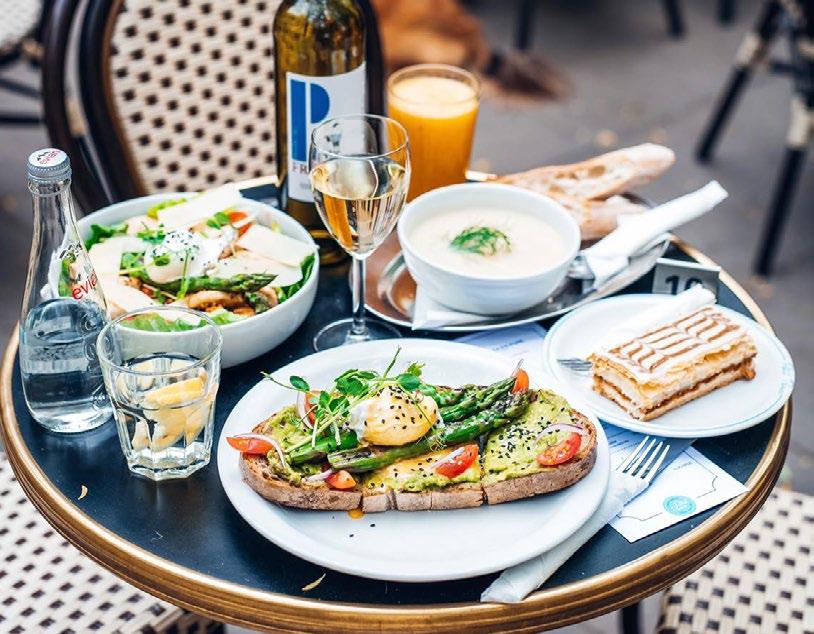
€ most mains under 25zł
€€ most mains 25-45zł
€€€ most mains 45-75zł
€€€€ most mains 75-115zł
€€€€€ most mains over 115zł
With 18 diverse dining establishments and bars, Food Fyrtel is Poznań’s food market haven. Located just outside of the Old Town area, its atmosphere is a unique fusion of urban energy and artistic style, providing a constant source of inspiration. From world cuisine to competitions showcasing young talents, this place caters to all ages and interests. Events, workshops, play areas, stand-ups, concerts, and games ensure that boredom is non-existent. Food Fyrtel is where delicious food, trendy interiors, and exciting events converge, making it a must-visit spot for friends and family seeking an unforgettable experience.QM -10, ul. Pleszewska 1, tel. (+48) 61 628 65 27, www.foodfyrtel.eu. Open 10:0022:00; Wed, Fri, Sat 10:00-00:00; Sun 10:00-21:00.
Located conveniently on the main square, this trendy hangout is perfect for quality time spent with friends, family and other notable crew. Why? Because Just Friends is all about shareable dishes, ranging from delicious meat and veggie platters that can satisfy up to six people, to mouthwatering burgers, wings, tacos, fries, falafel, hummus, and much more. Those visiting from abroad even have the opportunity to indulge in a selection of traditional Polish-style drinking snacks, that being herring, pickles, hard-boiled eggs, and kiełbasa. For those seeking a heartier meal, Just Friends serves respectable entrees such as fish & chips, pasta, and bao buns. On the other hand, those ordering for particular ravenous parties can grab a snack board set of strips, nuggets and the like from between 94 zł to 179 zł. The drinks are designed for sharing too, with options like the massive 3L ‘giga drink’ or the 2.5L ‘beer tower’. Put simply, it’s the ideal place to fuel up before a night out. Keep an eye out for their awesome summer garden and soon-to-be-finished pavement rennovations!QH-7, ul. Stary Rynek 80/82, tel. (+48) 570 99 99 00. Open 16:00-22:00; Fri, Sat 11:00-01:00; Sun 11:0022:00. (22-42zł) €€. TB6
Massimiliano Ferre
utensils Italian
Poznań’s good at keeping secrets, and they don’t come much better than this place. The site of one of the city’s historic bar establishments, MF does come across as a little unassuming – the stone cladding and a budget interior give it the slapdash look that suggest a seriously hurried/panicked opening. Looks aside, this spot stands alongside the very best Italian eateries in Poznań. The pizza is our personal highlight, though we’ve also heard lofty words about the beef fillet in black pepper sauce, as well as their very Polish boiled pork knuckles. On another note, their seasonal menu currently features the
chef’s love of asparagus! An unexpected gem, and well worth the look, especially now that warmer months have brought out their very suave pavement terrace set-up. is the place to be seen!QG-7, Pl. Wolności 14, tel. (+48) 61 852 81 12, www.mf-restauracja.pl. Open 11:00-22:00; Sat, Sun 12:00-22:00. €€. TU6
Petit Paris Sołacz utensils French
The Petit Paris in Stary Browar might be in the more central location, but to get away from the Old Town crowds and relax with a glass of lavender lemonade or Prosecco in hand we recommend making your way over to Sołacz. Here you can sit in the garden right next to Park Sołacki and enjoy French baked goods and bistro-style dishes like crepes, quiches, salads, confit duck, and all-day breakfast. There’s even a small delicatessen where you can buy various preserves and sweets. Bon appétit! QD-3, Aleja Wielkopolska 40A, tel. + (48) 61 890 56 03, www.petitparis.com.pl. Open 8:00-21:00; Thu, Fri, Sat 08:00-20:00; Sun 9:00-20:00. TUB6
utensils Kyrgyz
This delightful, bright, and simply-decorated holein-the-wall serves a truly underrepresented cuisineKyrgyz (as in, from Central Asian country of Kyrgyzstan). More than a novelty in this city, locals have been flocking to it ever since it opened up! U Aipo’s menu is short and to the point, offering the greatest Central Asian culinary hits - lamb kuurdak (meat with potatoes and onions), lagman (a brothy soup with hand-pulled noodles and meat), manty and samsa dumplings. A summer garden is also in action at the moment!QC-6, ul. Szamarzewskiego 8, tel. (+48) 609 65 53 18. Open 12:00-21:00; closed Mon. (19-56zł) €€. B6
utensils International
Not the easiest place to find despite being only a stone’s throw from the square, which makes its discovery (head into what looks like a shop to find it tucked away at the back) even more of a pleasant surprise. Clearly a labour of love as reflected by beautiful paper decorations set against the mismatch of wooden furnishings, exposed brick, and copious shrubbery. Spread over a number of small rooms, Zielona Weranda is one of our favourite lunch spots with a tasty, well-prepared range of soups, salads, burgers, and entrees like Poznań duck and roast salmon. The tea, coffee, and cake options are so encyclopaedic, the harder aspect of spending time here is deciding what to have.QH-7, ul. Paderewskiego 7, tel. (+48) 789 40 11 91, www.werandafamily.com. Open 10:00-22:00; Fri, Sat 10:00-23:00; Sun 10:00-20:00. €€.
TB6
utensils Polish
Set in the historic building that once housed (and will again someday, according to rumours) the Hotel Bazar, the name of this smart restaurant honours both the building and the year it was built. Looking far pricier from the outside than it actually is, the food scores well in the price to quality ratio, and is served by a friendly English-speaking staff. Along with imaginative interpretations of typical Polish dishes you’ll find pastas, salads, and a variety of original dishes. Every 3 to 4 months, they change their menu, so visiting more than once in a year is certainly recommended! Our current favourite from the mains is the Corn chicken with sorrel, mashed potatoes, seasonal vegetables, and it’s own roast chicken sauce! Expect to pay anywhere between 46-135zł for a course, whilst a soup goes from around 28zł. It’s fair to say that this is a place to impress without buckling the credit card, though you may have to protect the plastic from the exclusive shops nearby! QH-7, ul. Paderewskiego 8, tel. (+48) 61 222 68 64, www.bazar1838.pl. Open 12:00-22:00; Sun 12:00-19:00; closed Mon. €€€. UB
utensils International
A long-standing editorial favourite, thanks to their willingness to buck trends. Concordia Taste’s menu represents interpritations of Polish and regional cuisine, that is locally-sourced, seasonal, and produced with a strict zero-waste policy! is an ambassador of Polish wines, of which they have a selection of 150 different types, in addition to some foreign labels as well! QD-7, ul. Zwierzyniecka 3, Read more about Concordia Taste Poznań on p.10.
utensils International
‘Adventurous’ isn’t a word we often like to pair with the word ‘dining’, but this place proves to be the exception. As its name implies, Dark Restaurant is devoted to having diners eat their dinner in inky blackness. We’re not talking mood lighting, either - the cavernous room is so dark that the waiters actually wear night vision goggles! The idea here is that by impairing your sense of sight, you enhance your other senses, which makes for a more exciting dining experience. Each of the menu themes - bizarre food, mood food, and a more standard option - comes

with a variety of courses, and you aren’t told what you’re digging into until the meal is over. A messy and intriguing meal awaits you! At the end, you have the chance to talk with your waiter and the head chef, who delight in making you guess what you ate.QI-7, ul. Garbary 48, tel. (+48) 61 852 20 57, www.darkrestaurant.pl. Open 16:0021:00; Fri, Sat 15:00-22:00; closed Mon, Sun. €€€€€. 6
utensils Italian
Romantic repasts and serious business dinners take place amongst these starched tablecloths and vases of flowers. Prices are steep, though most Western visitors will have the spending power to indulge in their long list of pastas, beef tenderloin, veal, and an expansive wine list of mainly Italian produce. What Figaro is famous for though is its fresh fish and seafood, which is truly among the best in the city. Those wanting to really push the boat out may wish to take advantage of the restaurant’s VIP room, which can be hired out for those extra special occasions. The kitchen closes at 22:00 Mon-SatQG-8, ul. Ogrodowa 17, tel. (+48) 61 856 01 89, www.restauracjafigaro.eu. Open 13:00-23:00; Sun 13:00-18:00. €€€. T6

utensils Japanese
The City Park development just to the west of the centre (past the Trade Fairs) is home to some of the city’s best eating establishments and this is true for Kyokai, one of Poznań’s most notable Japanese efforts. The sushi is fresh and delicious, of course, and the menu also includes beef katsu, gyoza dumplings, misoshiru soup, various green teas, and other Japanese delights. Set in a series of converted red brick buildings, and with some rather chic surroundings, you can choose seating on either the upper or lower level. Take note, however, that being on the lower allows you to convers with the Kyokai sushi senseis, who can recommend something especially for you! Definitely one to check out. To get here, take tram 13 to the Wojskowa stop.QA-9, ul. Wojskowa 4 (Łazarz), tel. (+48) 519 37 61 82, www.kyokai.pl. Open 12:00-23:00; Sun 12:00-22:00. €€€. TUB6
utensils Thai
From fresh oysters, monkfish in red curry, and crispy duck, to classics like pad thai, green curry, and mango with sticky rice, this high-end Thai chain prepares veritable Southeast Asian feasts in a refined interior with dark wood, floral lattices, and Buddha ornaments. Top the experience off with a bottle of fine red, or try the 39zł lunches, served from 12:00 till 16:00 on weekdays.QA-9, ul. Wojskowa 4, tel. (+48) 885 19 98 85, www.thaithai.pl. Open 12:00-22:00; Fri, Sat 12:00-23:00; Sun 12:00-21:00. (32-128zł) €€€. TB6
Poznań bars are flexible - no matter what the official closing times are, most bars will stay open until the last customer has stumbled out. Most night spots are concentrated around the Old Town Square, but also check out ul. Nowowiejskiego (G-6), ul. Taczaka (F/G-8), beach bars on the shores of the Warta River (p.8), and Łazarz’s Social Night Market (p.69), all of which draw students in droves.

An assortment of snacks and small dishes like beef tartare, potato pancakes, and potatoes with quark cheese accompany a large selection of booze including vodka (they even make their own pear-flavoured kind), craft beer, Prosecco, and mixed drinks. It’s loud, it’s hip - there’s simply no escaping the exposed brick, fairy lights, and street-inspired wall art - and the folks here are having a good time. You can even purchase small bottles of that pear vodka as souvenirs for the whomever you left back home. On weekends, there are breakfast offers for 22zł and snacks (20-30zł) to grab between 16:00-19:00.QH-8, ul. Wrocławska 18 (entrance from ul. Jaskółcza), tel. (+48) 730 90 15 48. Open 19:00-02:00; Thu 19:00-04:00; Fri, Sat 19:00-07:00. 6
A vast multi-level jazz club whose spangly interior has shades of 90s club tragedy written all over it. Don’t let that discourage you, however; this is a legendary venue that has hosted some of the biggest names in Polish and international jazz. Do check their website for what’s cooking first - this space has been known to be rented out for teen hip-hop nights and other hooded-top twaddle, and if there’s no concert scheduled then they aren’t open.QF-7, ul. Kościuszki 79, tel. (+48) 61 851 04 08, www.bluenote.poznan.pl. Open 40 min before event; check website. E
Brovaria
Brovaria feels an integral part of Poznań life, and it’s certainly become established as the main expat haunt since the demise of Dom Vikingów. Yet while it feels an ingrained piece of Poznań one look at the design reveals a modern, industrial space, one where steel and glass combine to create a sharp looking area that looks as edgy now as when it first opened. However, coming here to admire the interiors would be missing the point; this place is all about beer, namely the excellent house lagers that are brewed out back in the copper vats. Here’s one of the best microbreweries in Poland, quite possibly the best: enjoy it.QH-7, Stary Rynek 73-74 (Brovaria Hotel), tel. (+48) 61 858 68 68, www.brovaria.pl. Open 12:00-24:00; Fri, Sat 12:00-01:00. (22-75zł). B
While the old town and other districts lend a pleasant backdrop to drinking and dining, there are certainly plenty of other alternatives to the standard format.

A summertime food truck extravaganza! Eat, drink and socialise in and around a rusty old railway depot and its abandoned train cars. Regular concerts spice up the evenings, while the food trucks and food shacks dole out Mexican, Asian, burgers, vegan eats, ice cream, and more. There’s just one catch: Getting here can be a bit complex, so check jakdojade.pl/ poznan for trams or just get an Uber. Open MaySeptember.Qul. Kolejowa 23, tel. (+48) 506 20 32 14. Open 16:00-24:00; Thurs 12:00-03:00; Fri 16:00-05:00; Sat 14:00-05:00; Sun 12:00-24:00; closed Mon, Tue. B
Occupying a stretch of grass along the Warta River, this stack of shipping containers surrounded by an artificial beach features live music and ‘art’ installations. To find it, head down Ewangelicka (J-7) toward the Warta River and follow the noise! Open from May till the end of September. QK-8, ul. Ewangelicka (on the Warta River between Chrobrego and Rocha bridges), www.kontenerart.pl. Open 14:00-2:30; Sat, Sun 12:00-02:30. BE6
Ogród Szeląg
This magical riverside could have easily been a beach bar, but instead this drinking and socialising spot has become an intimate, semi-wild garden with deck chairs and hammocks hidden among the foliage, serviced by a mint-green shipping container bar. With concerts every Friday, and a nice menu of waffles, bagles, and salads, this is a low-key hang-out even rents out kayaks (25zł for one hour, 35zł for two)! Awesome!Qul Ugory 97. Open 12:00-22:30; Fri 12:00-23:00; Sat 11:00-23:00; Sun 11:00-22:30. BE6
We were a little sceptical at the beginning but this place is unquestionably Poznań’s best sports bar. This isn’t the dark, divey venue you may be used to, rather a large modern space involving ice white sofas and a blue-lit bar. TVs aside, other bonuses include more than 120 beers (with 14 on tap), board games, and darts, as well as poker and foosball tables which seem to have a steady flow of players - Cooliozum is actually the training centre of the Polish Foosball Association. Head through the archway at no. 45 and find it down some stairs on your left.QG-7, ul. Św. Marcin 45, tel. (+48) 792 88 18 12, www.cooliozum. pl. 6

Step into the dragon’s den to find a musty bar dank with sweat and atmosphere. Popular with drop-outs and creatives, this weirdo has a recycled look, and peeling plaster walls onto which hallucinatory visuals get zapped. Things intensify as the night wears on, and being ‘dragoned’ is now accepted lexicon for the post-party cabbages you’ll note crawling out at closing. Dreadlocked eco-warriors love it, so don’t expect the most flowery of aromas. But why are these creatures from the alternative side of the mood congregating here? Well, there's two reasons: The first is Dragon's amazing courtyard beer garden, lined with plants and good vibes. The other gravitational draw is the live music program, which never fails to dissapoint! QH-7, ul. Zamkowa 3, tel. (+48) 61 853 08 19. Open 09:30-03:00. XUEW
Fort Colomb, part of the inner ring of old Prussian fortifications, sometimes gets overlooked on account of its location – a bit out of the old town and closer to the main train station - but it really shouldn’t. During the summer, we take every opportunity to get away from the hustle, bustle, and loud drunks of the main square and hide away in the leafy garden of this splendidly historic building, located right in Park Marcinkowskiego.QF-8, ul. Powstanców
Wielkopolskich, tel. (+48) 609 99 02 82, www. fortcolomb.pl. Open 14:00-00:00; Fri, Sat 14:00-01:00; Sun 16:00-00:00. XE
Once the city’s most representative street, Św. Marcin has long been a snooze lane crammed with mediocre establishments you’d hurry past on your way to the main square. Luckily, the tide is starting to turn with the addition of increasingly recommendation-worthy restaurants and barsand here’s one. Very ‘current’ what with the neons, exposed brick, and Pinteresty glassware, Miejscówka might not be the most original, but it does earn our seal of approval, and probably Instagram’s as well. The target group here is the more hipster types, so expect lots of whimsical cocktails and colourful shots.
QG-8, ul. Święty Marcin 29. Open 17:00-02:00.The newspapered interior and nostalgic communistera concept here are exactly the same as their dozens of locations all over the country (including a second in Poz at ul. Wrocławska 8, C-2): dirt cheap booze and dirt cheap grub like pickled herring and ‘awesome toasts’ to soak up the aforementioned booze. This place is packed at all hours, though it’s best sampled during the later stages of the evening when you’re guaranteed a right assortment of characters who are happy to spill out their life story for the price of a 5zł beer. Very ‘Polish’ and a welcome alternative to some of the Rynek’s more expensive and snobby bars. Karaoke nights take place Tue, Thu, and Sun 20:0002:00.QH-7, Stary Rynek 85, tel. (+48) 791 85 95 55, www.pwip.com.pl/poznan-rynek. Open 10:00-05:00; Sat, Sun 12:00-05:00. U
Heralded for its broad selection - around 200 bottled beers and 16 on tap - Piwna Stopa is wildly popular with beer connoisseurs who don’t give two craps about trendy light fixtures or the instagrammability of the interior decor. Not that it’s bad: there’s a certain Czech tavern feel what with the old-fashioned wooden chairs, wall lamps, framed miscellanea, and
fireplace (!) and live bands play jazz, blues, and rock during the warm season. Their leafy summer garden is highly recommendable, as are the cheese boards, smoked-sausage hot dogs, and other meaty treats (there’s even venison). Oh, and they recently added a 17th tap with vodka - that’s one we haven’t seen before!QI-6, ul. Szewska 7, tel. (+48) 532 32 92 77, www.piwnastopa.pl. Open 15:00-00:00; Thu 15:0001:00; Fri, Sat 13:00-02:00; Sun 13:00-00:00. 6
So what if Stalin killed umpteen times more people than Hitler? Communism can be a hoot, at least it is if you’re drunk, so head to this commie bar and raise a glass to Uncle Joe. Quality local lager, 5zł vodka shots, and - of course - an assortment of classic Eastern European drinking snacks like pickles and bread smeared with lard - ensure nights aren’t dull, and you’ll find this piece of socialist paradise decidedly stuffed with Cold War keepsakes and Iron Curtain mementos. Pride of place goes to Lenin, with his giant plaster head peering through the street-side window.QI-7, ul. Wrocławska 9, tel. (+48) 508 17 36 08. Open 17:00-02:00; Fri, Sat 17:00-03:00; closed Sun. 6
SPE is a natural born winner – few places are better geared to meet foreign demands, and while the prices are undoubtedly steep (do you expect anything else from the Sheraton?), it’s a place where foreigners and locals mix with seamless ease, chatting about travels while sports beam down from their 9 TVs. American in spirit, you’ll find Route 66 extras mingled with rock pics, a strong menu of Tex Mex, burgers, and steaks, as well as more whimsical touches such as a car bonnet bursting from the wall. Taking centre stage is a circular bar, the perfect base to chat to staff while they fix earthquake cocktails and velvet smooth Guinness. Happy hours commence at 18:00 and go until 20:00 Tue-Sat.QD-7, ul. Bukowska 3/9 (Sheraton Poznan Hotel), tel. (+48) 61 655 20 00. Open 18:00-00:00; Fri, Sat 18:00-01:00; closed Mon, Sun. UBE
The spotlight here is firmly on wiśniówka, traditional Polish cherry vodka made in small batches by Wiśniewski’s crew. With bottles of their product lining the walls, discrete neons, and huge cherry lights dangling from the ceiling, this unique bar offers more than your run-of-the-mill alcohol experience. Grab a shot for 11zł or a 0.7L bottle for 79zł.QH-7, ul. Wrocławska 21/2, tel. (+48) 693 07 07 70, www. wisniewski.ltd. Open 16:00-24:00; Fri, Sat 24:00–12:00; Sun 24:00-12:00. UB6
Thirty seconds from bustling Półwiejska Street, Casa de Vinos wine bar serves as an ideal stop-off for those who know they deserve a relaxing glass of wine (or two) after a hard day of shopping and sightseeing. The friendly and knowledgeable staff are happy enough to talk you through the 300 plus bottles on display before offering you a comfy seat in which to enjoy your final choice. It’s small, it’s intimate and it makes for a perfect little place to sample some of the finest wines from around the globe. Keep your credit card at hand - you’ll be needing it when it comes to ordering a bottle or three to take back home.QH-8, ul. Krysiewicza 5/2, tel. (+48) 61 815 28 26, www. casadevinos.pl. Open 11:00-22:00; Mon 11:00-18:00; closed Sun.
Refined but mercifully laid back (leave that tie at home), ISTNY offers a selection of 14 wines, 8 beers, and 2 ciders - all on tap - in a hip, industrial interior. Make sure to grab an assortment of tapas, which include pickled garlic cloves, prosciutto, chorizo, jamón serrano, and olives.QH-8, ul. Podgórna 12, tel. (+48) 606 61 04 30. Open 18:00-24:00; Fri, Sat 18:0002:00; closed Sun. 6
Wino na Kieliszki
The city’s first self-serve wine bar, ‘Wine by the Glass’ lets you pour your own vintage from a selection of forty. Just load up a pre-paid card by the bar, order a cheese board or some nice tapas, and enjoy your Dionysiac evening. Strongly recommended. QG-6, ul. Młyńska 12, tel. (+48) 61 627 03 00, www.mlynska12.pl. Open Fri, Sat 18:00-00:00; closed Mon, Tue, Wed, Thu, Sun. 6

Not exactly Poland’s party capital, Poznań nevertheless has a functional clubbing scene for the city’s college students and revellers to blow off steam. Though some establishments only open their doors on weekends or select days of the week, nearnightly thrills are available at Cuba Libe (closed Sun), and the big cheese in town is the international franchise Pacha (yes, the place with the cherries).
Credit crunch you say? Not in Poznań, people. While the rest of the world staggers around like a shot pig the denizens of Poznań are living the high life in places like Czekolada. To call this place sexy would be a disservice; this is the final word in design drinking and the sort of cocktail spot/lounge club the city deserves. Huge chandeliers, shiny surfaces, and black finishes lend a real svelte look to this spot, and you’d be a fool to turn up looking like anything less than a celebrity. To make a reservation, head to their website of facebook.QH-8, ul. Wrocławska 18, tel. (+48) 665 55 08 91, www.klubczekolada.pl. Open Thu, Fri, Sat only 23:00-05:00. X
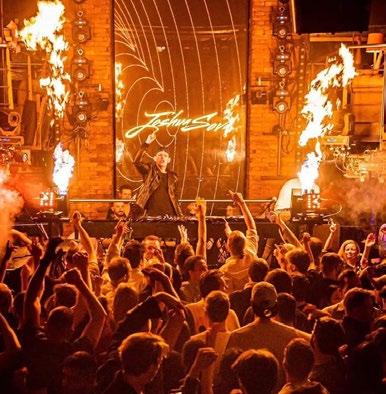
Set down a shadowy courtyard basement, Cuba Libre is a bouncy Latin venue replete with whitewashed walls, pics of Che, and wall space dedicated to an assortment of Cuban goodies. This place goes for detail, so much so that drinkers can even take a seat in one of those clapped-out vintage bangers you see pootling round the streets of Havana. The Fridaynight ‘MUY Caliente’ and Saturday-night ‘ESTA NOCHE FIESTA!’ dance parties prove seriously popular.QH-8, ul. Wrocławska 21, tel. (+48) 61 855 23 44, www.cubalibre.pl. Open 22:00-05:00; closed Sun. XE
An extension of dance-scene favourite Cuba Libre, the Social Club is an exclusive Cuban-themed cocktail bar with a focus on fine rum; try, for instance, their mojito made with Havana Club Añejo 3 años white rum. Frequent live Latin American music and DJ parties keep the tunes on-brand and the patrons attempting the samba.QH-8, ul. Wrocławska 21, tel. (+48) 605 04 07 66, www.cuba-libre.pl. Open 18:0001:00; Fri, Sat 18:00-03:00. BE
Pacha? As in, the world’s most famous clubbing franchise Pacha? In Poznań? We’re as shocked as you, but yep, those cherries are real, and this is the only Pacha in post-communist Central Europe - validating Poznań’s growing international rep as a prime party city. Decked out in plush design and pumping out house music for the masses, Pacha is a divorcee’s paradise and one which is attracting big crowds looking to dance away those working-week blues. Will its reputation be enough to pull in the punters from Warsaw, Wrocław, and Berlin? Time will tell...
QH-7, ul. Paderewskiego 10, tel. (+48) 61 665 72 44, www.pachapoznan.com. Open Thu, Fri, Sat 22:0006:00. X
Inspired by the Berlin party scene - in fact, conceived as a direct result of the to-be owners’ wild night at techno club Berghain - Projekt LAB is an experimental space and underground music venue that proved an immense hit as soon as it opened doors in 2013. The music of choice here is electronic and all sorts of alternative beats, often supplied by international DJs and bands. Brave the long entry lines and you’ll be rewarded with a true multimedia experience.QI-6, ul. Grochowe Łąki 5, tel. (+48) 731 47 71 02, www.projektlab.pl. Open Thu 22:00-04:00; Fri, Sat 23:00-07:00. XB
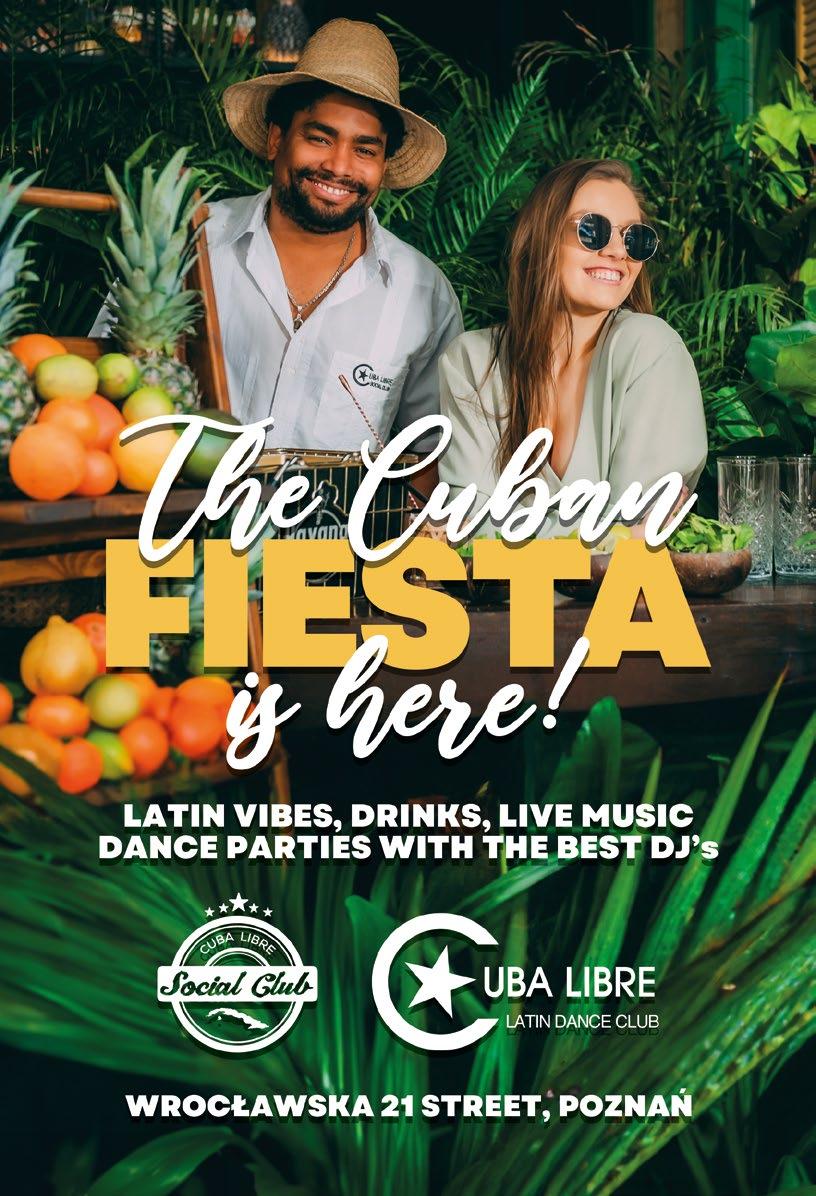
Print space is finite, but the internet is a vast vacuous void we’ve devoted our lives to filling. If the venue you’re looking for isn’t listed here, you’ll likely find it amongst the hundreds of places in Poznań listed on our website: poznan.inyourpocket.com






